DashClicks Blog
The industry's top experts offer their best advice, research, how-tos, and insights—all in the name of helping you level-up your business and online marketing skills.
Join Us!
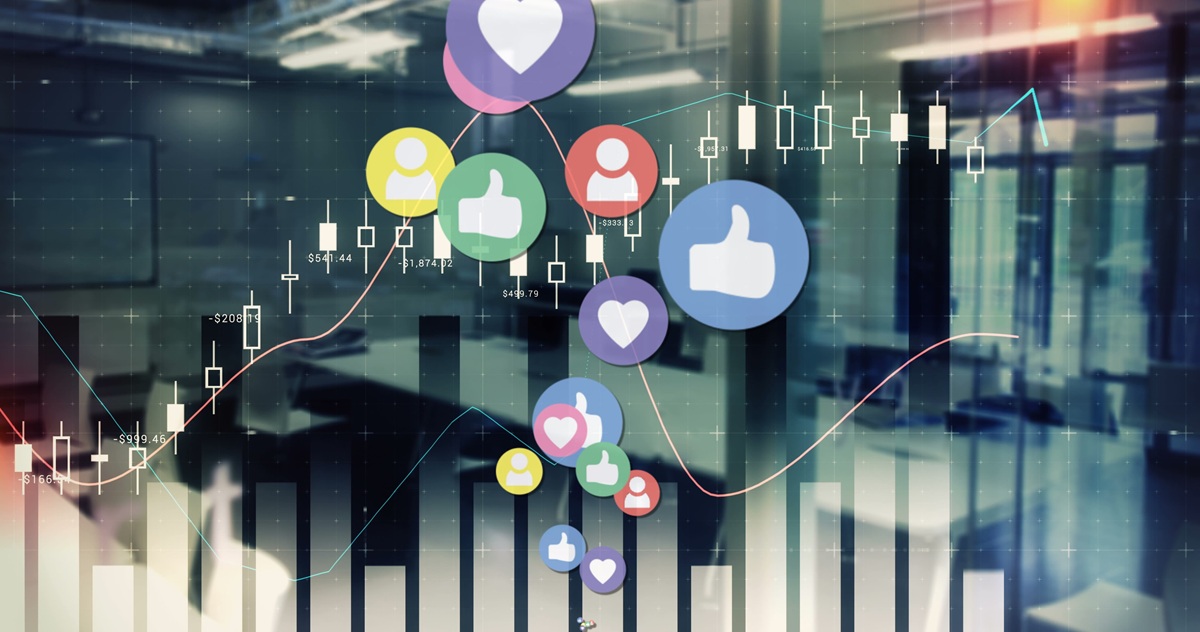
Outsource Facebook Ad Management: Match Benchmarks Without In-House Staff
Running Facebook ads in 2025 looks very different from just a few years ago. Costs are higher, competition is tougher, and the platform itself keeps changing. Agencies feel this pressure every day. Clients expect steady leads, predictable costs, and clear reporting. At the same time, hiring and retaining skilled Meta ad specialists has become expensive and risky. One wrong hire or sudden resignation can slow performance across multiple accounts.
Recent industry data shows why this challenge keeps growing. WordStream’s latest benchmark summaries point out that average cost per click and cost per acquisition continue to fluctuate across industries. E-commerce and lead generation brands now face CPCs that are often 10 to 20 percent higher than pre-2023 levels. TripleWhale and Lebesgue reports also highlight ongoing CPM volatility, with some US markets regularly crossing the $20 mark during peak seasons. These changes mean that basic campaign setups are no longer enough.
This is where outsourcing becomes a practical option rather than a shortcut. White label Facebook ad partners give agencies access to specialists, tools, and proven workflows without expanding internal teams. The goal is not just to save time but to match or exceed performance benchmarks while staying profitable.
This blog explains why agencies struggle to hit current benchmarks on their own, what white label Facebook ads management actually delivers, and how to measure success using real KPIs. It also takes a closer look at how DashClicks supports agencies that want consistent Facebook ad results without hiring in-house staff.
Why Do Agencies Struggle to Hit Facebook Ads Benchmarks?
As Facebook advertising becomes more complex, many agencies find it harder to keep performance aligned with current benchmarks. The challenge is rarely a lack of strategy. More often, it comes down to execution limits, time constraints, and the growing demands of the platform itself.
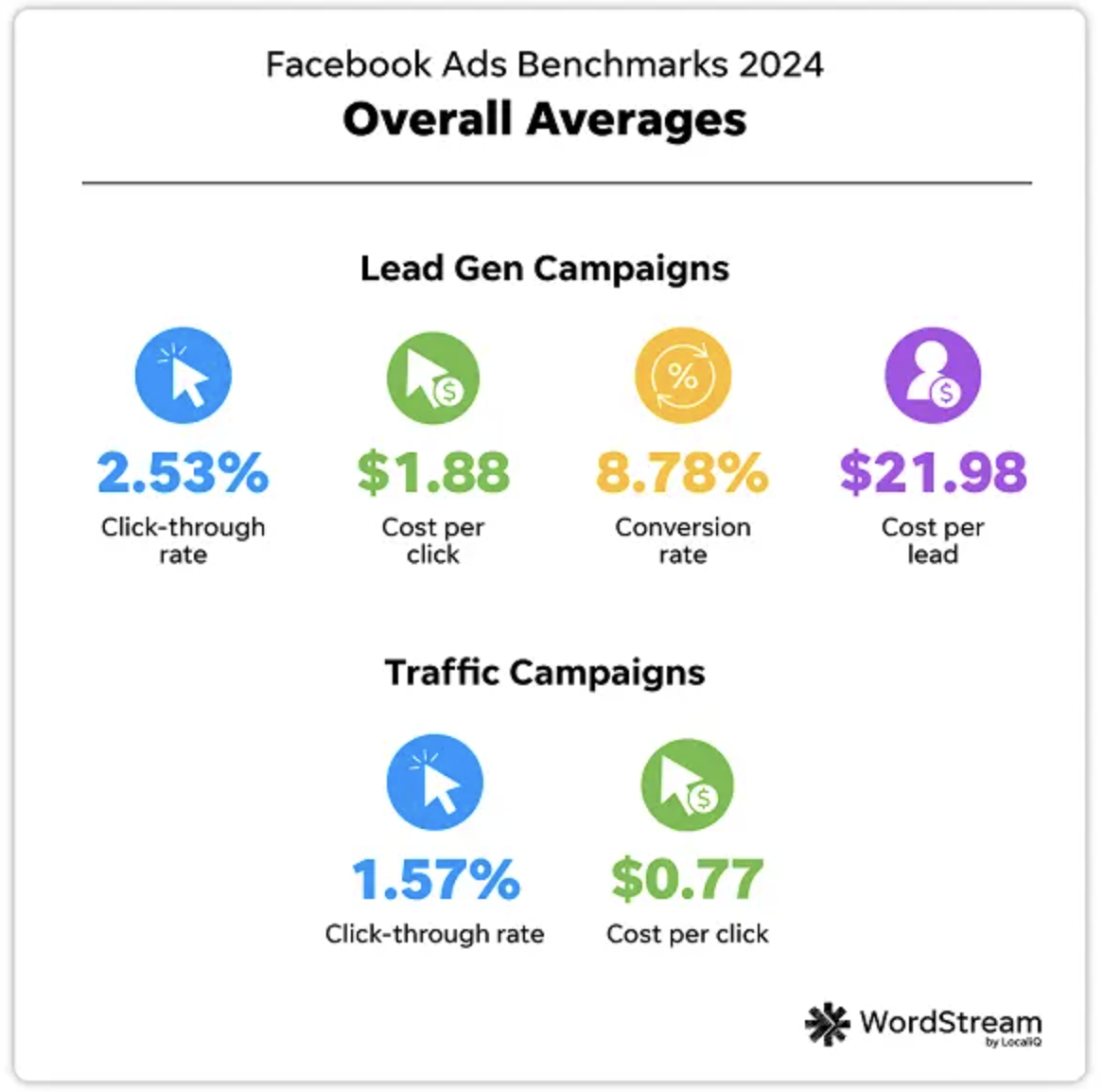
Image Source: WordStream
Three issues stand out as the most common roadblocks in 2025.
1. Rising Auction Costs and CPM Volatility
Meta’s ad auction grows more competitive every year. As more brands shift budget into paid social, bids increase and CPMs change rapidly, sometimes within the same day. Industry data from Lebesgue shows that average CPMs in the US have crossed the $20 mark across many verticals, with sharp differences by region, audience type, and seasonality. For agencies managing multiple accounts, keeping up with these swings is difficult without advanced budget controls and daily monitoring.
When CPMs spike and budgets are not adjusted fast enough, campaigns become inefficient. Prospecting campaigns often absorb too much spend, while retargeting is underfunded. Over time, this imbalance leads to rising acquisition costs and inconsistent results.
How this hurts benchmarks:
- Higher CPMs directly push up CPC and CPA when optimization lags.
- Budget waste increases during peak competition periods.
Signals to watch:
- CPM trendlines are increasing week over week.
- Uneven spend distribution between prospecting and retargeting campaigns.
2. Creative Fatigue and the Scale of Testing Required
Creative is now the single biggest performance lever on Facebook. Meta has repeatedly emphasized that ad quality and engagement heavily influence delivery and costs. In practical terms, this means agencies must launch and test new creatives constantly to maintain strong click-through rates. In 2025, testing a few ads per month is no longer enough.
Most small and mid-sized teams struggle to produce fresh visuals, copy, and formats at the pace required. As a result, ads stay live too long, audiences lose interest, and performance slowly declines. CTR drops, CPC rises, and the algorithm shifts delivery toward higher-cost impressions.
How this hurts benchmarks:
- Aging creatives lose relevance and engagement.
- Declining CTR increases CPC and weakens overall efficiency.
Signals to watch:
- Gradual CTR declines as creatives age.
- Noticeable performance drops after 7 to 10 days without a creative refresh.
3. Measurement Fragmentation After iOS and Attribution Changes
Even years after major iOS privacy updates, measurement remains one of the biggest challenges in Facebook advertising. Relying on pixel data alone no longer gives a complete picture of performance. Without server-side tracking and proper event mapping, reported conversions often underrepresent actual sales or leads.
Varos benchmark data highlights consistent gaps between platform-reported conversions and backend CRM or e-commerce data. When agencies optimize based on incomplete numbers, they pause winning campaigns, scale the wrong ads, and misjudge true CPA. Over time, this leads to wasted spend and missed growth opportunities.
How this hurts benchmarks:
- Inaccurate CPA reporting causes poor optimization decisions.
- High-performing campaigns may be underfunded or shut down too early.
Signals to watch:
- Conversion mismatches between Meta reports and CRM or sales data.
- Low percentage of conversions tracked through server-side events.
Together, these challenges make it increasingly difficult for agencies to hit Facebook ads benchmarks on their own. Without specialized tools, consistent testing, and accurate measurement, even well-planned campaigns struggle to deliver stable, cost-efficient results at scale.
4. Lack of Specialist Performance Operations
Running Facebook ads at scale takes far more than setting up campaigns and monitoring basic metrics. In 2025, strong performance depends on advanced bidding strategies, conversion value optimization, and precise audience engineering. These tactics require hands-on expertise and constant refinement. Agencies that rely on generalists often lack the depth needed to apply these methods consistently across multiple accounts.
When spending increases, small inefficiencies quickly become expensive. Without specialists managing scaling rules and bid strategies, performance becomes unpredictable. Campaigns that look profitable at lower budgets start to struggle as spend grows.
How this hurts benchmarks:
- ROAS becomes unstable as budgets scale.
- CPA rises faster than overall ad spend.
Signals to watch:
- CPA increasing disproportionately compared to budget growth.
- Flat or declining ROAS despite higher spend.
5. Insufficient Testing Cadence and Statistical Confidence
Consistent improvement in Facebook ads comes from ongoing testing. Audiences, creatives, and placements all need to be tested in parallel to find what truly drives performance. Small teams often lack the time and resources to run enough experiments to reach statistical confidence. As a result, decisions are based on limited data rather than clear trends.
Varos data shows that advertisers running fewer than five tests per month experience slower performance gains. Without a steady testing cadence, agencies struggle to make meaningful improvements that keep up with rising costs.
How this hurts benchmarks:
- Performance gains happen too slowly to counter increasing CPMs.
- Winning strategies take longer to identify and scale.
Signals to watch:
- Low number of tests launched each month.
- A long time is required to reach confident results.
6. Inefficient Tech Stack and Delayed Reporting
Outdated tools and manual reporting processes slow down optimization. When teams review performance data days after campaigns run, they miss critical windows to adjust bids, budgets, or creatives. TripleWhale research shows that delayed insights often lead to overspending during high-CPM periods, especially in competitive markets.
Without real-time dashboards and automated alerts, agencies react too late. This delay increases costs and reduces overall efficiency.
How this hurts benchmarks:
- Late optimizations push CPC and CPA higher.
- Budget waste increases during volatile auction periods.
Signals to watch:
- Long delays between data collection and decision-making.
- High reliance on manual optimizations and reports.
7. Difficulty Hiring and Retaining Meta Ad Talent
Experienced Facebook ad specialists are in high demand. Salaries have increased, competition for talent is strong, and turnover remains a challenge. When key team members leave, campaign performance often suffers. New hires need time to understand accounts, leading to inconsistent execution and missed opportunities.
Frequent staff changes also affect client confidence. When results fluctuate and account managers change often, clients question long-term stability.
How this hurts benchmarks:
- Performance varies widely across accounts.
- Client trust weakens due to inconsistent results.
Signals to watch:
- High turnover among ad operations staff.
- Short average tenure of Facebook ad managers.
These challenges are not signs of poor strategy. They are execution issues that naturally emerge as agencies grow. Addressing them requires a structured, repeatable approach to Facebook ad management that goes beyond what most in-house teams can sustain on their own.
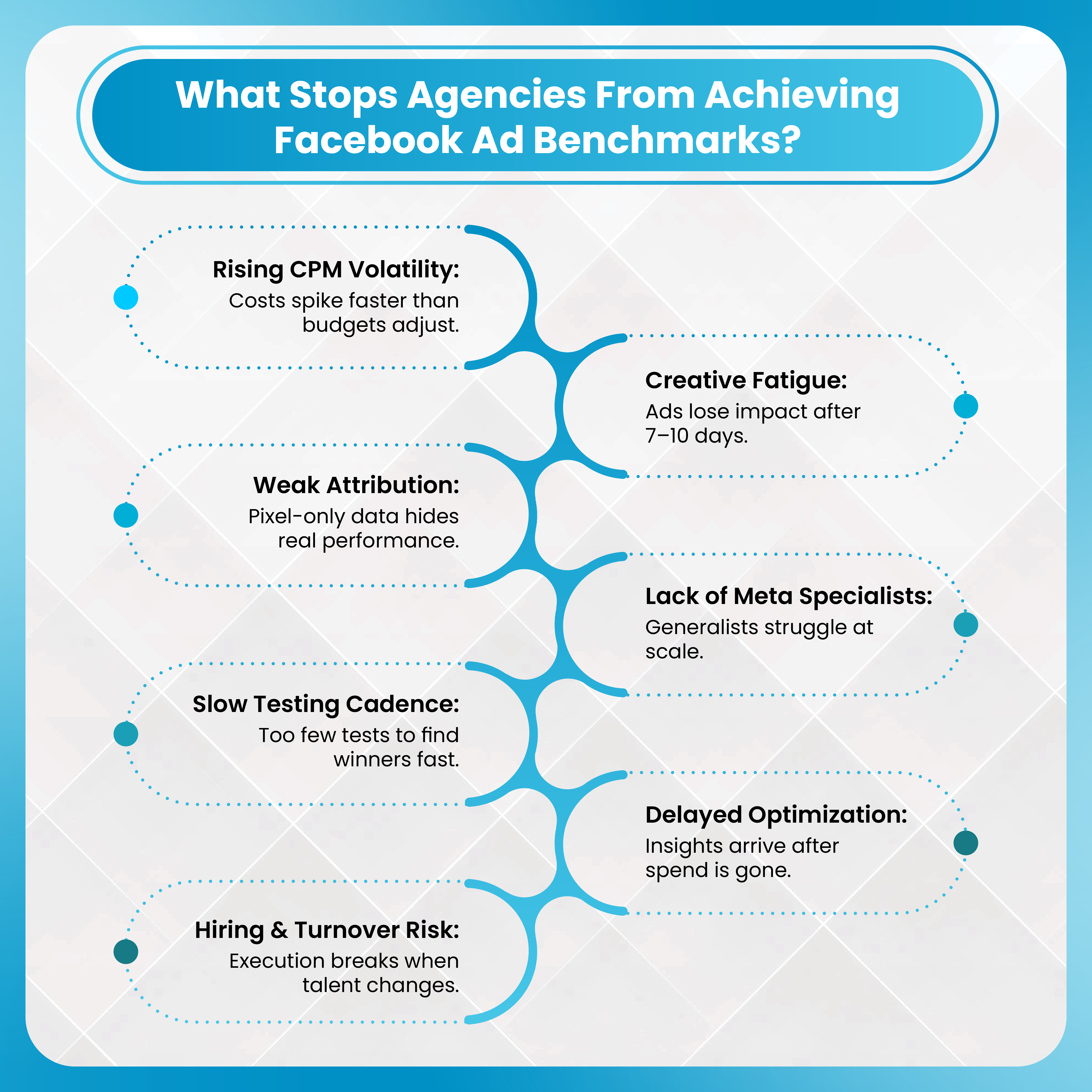
How White Label Facebook Ad Management Helps Agencies Meet or Exceed Benchmarks?
1. Engagement Models and Partner Promise
White label Facebook ads partners offer flexible ways to work. Agencies can choose fully managed accounts, co-managed setups, or audit-based support. Most partners provide rebrandable reports, dedicated performance leads, and service level agreements for optimization cadence.
KPIs to track:
- Optimization frequency.
- Client reporting consistency.
2. Rapid Creative Testing and Production at Scale
Creative testing becomes easier with a partner that has ready templates and production workflows. Short-form videos, static images, and carousel ads are tested in batches. WordStream benchmarks show that maintaining CTR above industry averages helps offset rising CPCs.
KPIs to track:
- CTR by creative group.
- CPC changes after new launches.
Example: Rotating six new creatives per week can help stabilize engagement and reduce wasted spend.
3. Advanced Bidding, Budget Allocation, and Campaign Structure
White label Facebook advertising team handles complex setups like blended bidding and budget shifting between funnel stages. They monitor performance daily and adjust spend to protect CPA targets.
KPIs to track:
- CPA versus spend curve.
- ROAS stability at higher budgets.
Micro Play: Reallocating 20 percent of spend to high-intent retargeting during CPM spikes can keep costs within benchmark ranges.
4. Reliable Measurement and Reconciliation
Accurate tracking is essential. Partners implement Conversion API, server-side events, and reconciliation dashboards. Various insights show that advertisers with stronger measurement setups report more reliable conversion rates.
KPIs to track:
- Percentage of server-side events.
- Alignment between reported and actual sales.
5. Scaled Operations and Automation
Automation rules help manage scale. Low performers are paused quickly, while winners are expanded. Testing calendars ensures steady improvements.
KPIs to track:
- Tests per month.
- Percentage of winning tests scaled.
Example: Running ten parallel A/B tests can accelerate learning and improve conversion rates over time.
6. Cost Control and CPM Efficiency
Partners apply geo-based bidding, placement prioritization, and day-parting strategies. Lebesgue data shows that CPMs vary widely by country, making geo optimization essential.
KPIs to track:
- CPM by region.
- Spend efficiency ratios.
7. Creative to Conversion Funnel Optimization
Ads do not work alone. The best white label Facebook ads team also focuses on landing page alignment and offer testing. Improving post-click experience raises conversion rates and lowers CPA.
KPIs to track:
- Conversion rate lift.
- Bounce rate changes.
8. Reporting, Dashboards, and Cadence
Clear reporting builds trust. White label dashboard like DashClicks compares performance against benchmarks from sources like WordStream, TripleWhale, and Varos.
KPIs included:
- CPC, CPM, CTR, CVR, CPA, ROAS
- Tests per month and tracking coverage.
9. Pricing and ROI Impact for Agencies
Most white label services charge based on ad spend or flat monthly fees. When CPA improves even slightly, agency margins increase. Using conservative benchmark improvements from WordStream averages, many agencies see positive ROI within the first few months.

Not all white label Facebook advertising solutions are built for benchmark-level performance. This is where DashClicks stands out.
How DashClicks’ White Label Facebook Ads Services Support Agencies?
DashClicks offers scalable white label Facebook ads management designed specifically for growing agencies. Their approach focuses on consistent optimization, creative testing, and budget control aligned with benchmarks. Agencies gain access to experienced teams that manage campaigns, test creatives, and adjust bids without exposing the backend process to clients.
DashClicks also supports accurate measurement through server-side tracking and clear reporting. Rebrandable dashboards make it easy for agencies to share results and explain performance trends. By handling the operational side of Facebook ads, DashClicks allows agencies to deliver strong results without expanding in-house teams or increasing overhead. This makes their Facebook ad services a practical choice for agencies aiming to deliver the best Facebook advertising campaigns.
Conclusion
Facebook advertising demands speed, specialization, and constant testing. Rising costs and platform changes make it hard for agencies to rely only on in-house teams. Outsourcing Facebook ad management through a white-label partner helps agencies meet current benchmarks while staying flexible and profitable.
By leveraging expert operations, advanced measurement, and scalable creative production, agencies can maintain strong performance without the burden of hiring and retention. DashClicks provides the structure and support needed to deliver consistent results and keep clients confident in their ad spend.
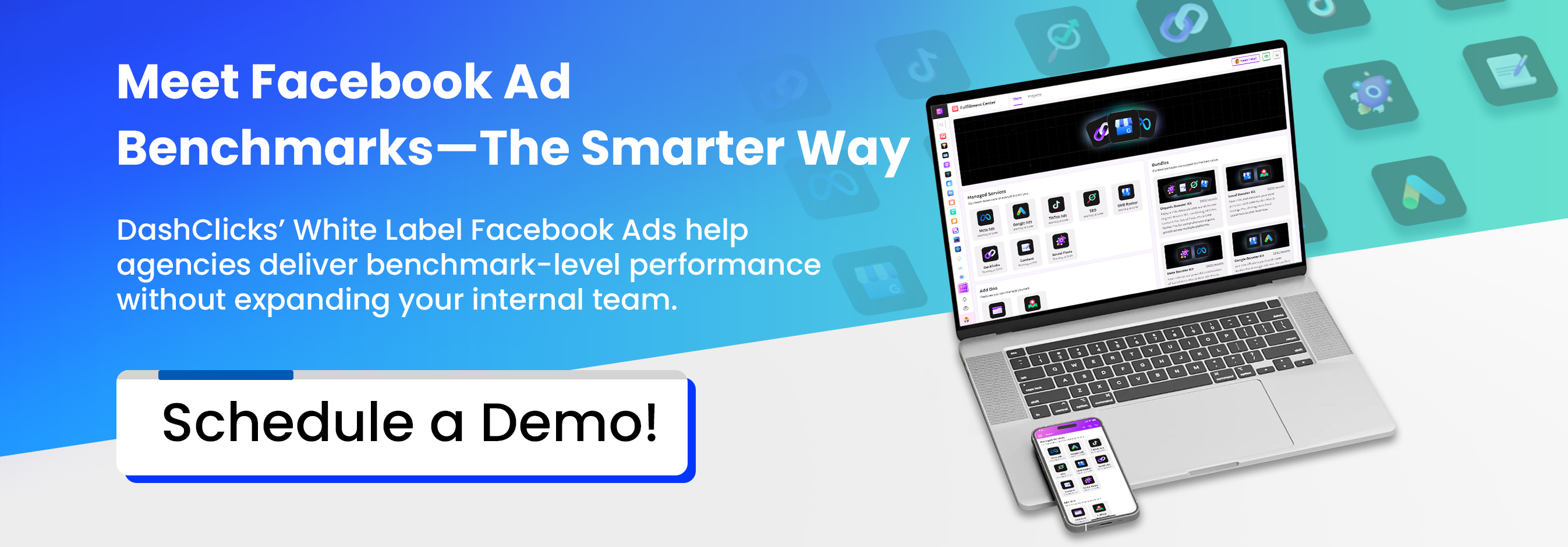

Technical SEO at Scale: How White Label SEO Partner Supports Site Health
When websites grow, technical SEO becomes less forgiving. A single crawl issue, broken redirect, or Core Web Vitals drop can quietly undo months of content and link-building work. For agencies managing multiple client websites, the challenge multiplies. One missed alert or a delayed fix across a large portfolio can lead to traffic losses, ranking volatility, and unhappy clients.
Technical SEO at scale means maintaining crawlability, indexability, clean site architecture, strong Core Web Vitals, efficient server delivery, accurate structured data, and smart internal linking across dozens or even hundreds of sites. It is not a one-time task. It is an ongoing operational discipline that requires systems, people, and repeatable processes.
This is where a white label SEO partner becomes valuable. Instead of building and maintaining large in-house technical teams, agencies can rely on white label SEO services to deliver consistent site health improvements behind the scenes. The agency keeps control of client relationships, while technical execution runs smoothly in the background.
Outsourcing is no longer the exception. According to Floowi, 61% of agencies outsource at least one core SEO service, and many plan to increase outsourcing as they scale. At the same time, organic search remains one of the most important traffic drivers. BrightEdge reports that organic search accounts for over half of all website traffic across many industries, reinforcing how critical SEO performance is to long-term growth.
In this article, we will break down the real technical SEO challenges agencies face at scale, explain how a white label SEO agency solves these issues, and show how DashClicks supports agencies with scalable, reliable technical SEO solutions that protect site health as client portfolios grow.
Common Scaling Pain Points Agencies Face
Managing technical SEO for one website is usually straightforward. You crawl the site, fix what is broken, and move on. When that same process needs to be repeated across dozens of clients, the cracks start to show. Scaling technical SEO is not just about running more audits. It is about maintaining consistency, speed, and clarity as complexity grows.

Below are the most common pain points agencies face, why they matter, and how they impact performance and client relationships.
1. Inconsistent Site Health Monitoring Across Clients
One of the earliest problems agencies encounter at scale is inconsistent monitoring. As client counts grow, monitoring often becomes uneven. High-priority accounts may receive frequent crawls and proactive checks, while smaller or newer clients are reviewed less often.
This inconsistency creates blind spots. Technical issues do not announce themselves politely. A single deployment can introduce broken internal links, duplicate URLs, accidental noindex tags, or JavaScript rendering problems. If a site is not being monitored regularly, those issues can sit unnoticed for weeks.
By the time a problem surfaces, the damage is already done. Rankings slip, organic traffic declines, and clients start asking uncomfortable questions. From their perspective, the drop feels sudden. From the agency’s perspective, it was avoidable.
The impact shows up clearly in reporting. Key metrics affected include:
- Overall site health scores.
- Number and severity of crawl errors.
- Frequency of technical checks per site.
- Variation in health scores across the client portfolio.
Many SEO platforms use a site health score as a standardized benchmark. This makes comparisons easy, but it also exposes inconsistencies. When one client sits at a 92 percent health score and another at 58 percent, agencies are forced to explain not only the gap, but why it was allowed to exist for so long. Over time, this erodes confidence and increases churn risk.
2. Manual, Ad Hoc Audits That Do Not Scale
Manual audits are thorough, but they are also time-intensive. For a single site or a small client list, this approach works. At scale, it becomes a bottleneck.
Agencies often rely on senior SEO specialists to conduct audits one by one. Each audit requires crawling the site, analyzing templates, reviewing indexation, and documenting issues. When client volume increases, audits pile up faster than teams can complete them.
The result is a growing backlog. Fixes are delayed, and issues that could have been resolved quickly remain open. This is especially problematic when agencies manage multiple sites built on the same CMS or theme. The same technical problems appear repeatedly, yet each audit treats them as new discoveries.
This slows down remediation and limits growth. Technical SEO opportunities often depend on timing. Delayed fixes can mean missed ranking improvements, slower recoveries after site changes, and prolonged performance dips.
The metrics most affected include:
- Audit turnaround time.
- Number of open technical issues per client.
- Time from issue discovery to resolution.
- Percentage of recurring issues across similar sites.
As these numbers worsen, operational stress increases. Teams feel stretched, quality becomes inconsistent, and agencies struggle to maintain service standards across their entire client base.
3. Fragmented Tooling and Disconnected Data
Another major challenge at scale is tool sprawl. Many agencies accumulate tools over time: one crawler for audits, another for monitoring, separate platforms for page speed, log analysis, and rank tracking. Add spreadsheets and internal dashboards, and data quickly becomes fragmented.
While each tool may be useful on its own, the lack of integration creates inefficiencies. Teams spend hours exporting, importing, and reconciling data instead of acting on it. Important insights get buried across tabs and platforms.
This fragmentation directly affects responsiveness. When an issue arises, it takes longer to detect and even longer to understand its impact. Mean time to detect issues increases, as does mean time to resolve them. At scale, the overhead of managing data can rival or exceed the effort required to fix the issues themselves.
The problem becomes especially visible during reporting or crisis moments. When a client experiences a sudden traffic drop, agencies must quickly piece together data from multiple sources. Delays and incomplete answers weaken trust, even if the technical team is working hard behind the scenes.
Over time, disconnected data makes technical SEO feel reactive rather than proactive. Instead of preventing problems, agencies find themselves constantly responding to them, which is unsustainable as client numbers grow.
Scaling technical SEO is not just about doing more work. It is about building systems that ensure consistency, speed, and visibility across every client. Without those systems in place, even skilled teams struggle to keep site health under control as portfolios expand.
4. Core Web Vitals Regressions After Launches
Core Web Vitals are no longer a nice-to-have. Google has clearly positioned them as part of its broader page experience signals, which means performance issues can translate into real visibility losses. The challenge for agencies is that regressions often appear after moments that are meant to improve a site.
Redesigns, plugin updates, new tracking scripts, and feature launches are common triggers. Even small front-end changes can affect how a page loads or responds to user input. A new hero image can delay Largest Contentful Paint. A chat widget can interfere with Interaction to Next Paint. Minor layout tweaks can introduce unexpected Cumulative Layout Shift.
What makes this difficult at scale is speed. These regressions do not always cause immediate, dramatic drops. Instead, impressions slowly decline, engagement metrics worsen, and rankings soften over time. By the time the issue is flagged manually, weeks of performance data may already be lost.
Agencies managing multiple sites need continuous, automated monitoring tied directly to deployments and releases. Without it, performance problems are often discovered too late, during monthly reporting or after a client raises concerns.
Key indicators to monitor include:
- Changes in LCP, INP, and CLS before and after launches.
- URLs that fall out of Core Web Vitals “good” thresholds.
- Correlations between performance dips and release timelines.
At scale, the goal is not just measurement but early warning. Catching a regression within hours or days can mean the difference between a quick fix and a prolonged ranking decline.
5. Technical Debt Across Legacy Platforms and Migrations
Many client sites are not built from scratch. They are the result of years of changes, patches, and partial updates. Over time, technical debt accumulates quietly. Duplicate content spreads across parameterized URLs. Redirect chains grow longer. Canonical tags fall out of sync. Templates become bloated and inefficient.
On stable sites, this debt slowly drags down crawl efficiency and index quality. During migrations or platform upgrades, it becomes dangerous.
Migrations amplify every existing weakness. A single missed redirect can break link equity. Incorrect noindex rules can remove entire sections from search results. URL structure changes can confuse crawlers and users alike. Even well-planned migrations can go sideways when legacy issues are not fully mapped beforehand.
Organic traffic losses after migrations are rarely caused by one mistake. They are usually the result of many small technical failures compounding at once. Recovery then takes time, effort, and client patience.
Metrics that matter most in these scenarios include:
- Indexed page counts before and after migration.
- Redirect error rates and redirect chain depth.
- Crawl stats and server response patterns.
- Post-migration traffic recovery timelines.
At scale, agencies struggle to apply the same level of rigor to every migration. Without standardized checklists, automated validation, and post-launch monitoring, technical debt continues to resurface, undermining trust and long-term performance.
6. Limited Engineering Bandwidth
Even when issues are clearly identified, fixing them is not always straightforward. Most agencies do not have dedicated engineering resources assigned solely to SEO. Technical recommendations must compete with other priorities such as design updates, feature development, or client-requested changes.
As a result, SEO fixes are often delayed. Simple changes sit in backlogs. Structural improvements are postponed indefinitely. Over time, this creates a gap between what was promised and what is delivered.
This limitation forces difficult trade-offs. Agencies may focus on quick wins that are easier to implement, while larger foundational issues remain unresolved. While this can protect short-term results, it weakens long-term site health and limits growth potential.
The impact shows up in client conversations. Expectations were set around performance improvements, but timelines slipped due to dependencies outside the SEO team’s control. Retention becomes harder when progress feels slow or uneven.
At scale, limited engineering bandwidth is not just a resourcing issue. It is a coordination problem. Agencies that lack clear prioritization frameworks and repeatable implementation processes find themselves constantly negotiating for fixes instead of executing them efficiently.
Together, these challenges make scaling technical SEO far more complex than simply adding more clients. Without consistent monitoring, structured remediation, and reliable implementation support, even strong strategies struggle to deliver predictable results across a large portfolio.
7. Lack of Repeatable, White Label Processes
One of the biggest barriers to scaling technical SEO is the absence of repeatable, white label processes. When every client is handled differently, growth becomes messy. Onboarding slows down, internal teams spend more time figuring out what to do next, and quality varies from account to account.
Without standard workflows, each new website feels like a clean slate. Audits are structured differently, tools are configured inconsistently, and reporting formats change based on who is managing the account. This increases the chance of missed steps during onboarding, especially for complex sites or time-sensitive launches.
The lack of repeatability also limits commercial growth. Technical SEO becomes harder to package as a clear service when delivery depends on individual effort rather than a defined system. Upselling becomes uncomfortable because timelines and outcomes feel unpredictable. Sales teams struggle to explain what clients will actually receive, and delivery teams feel the pressure once expectations are set.
From a quality standpoint, inconsistency is the real risk. Some clients benefit from thorough monitoring and fast remediation, while others receive only periodic attention. Over time, this creates uneven results across the portfolio and makes it difficult to maintain a consistent brand promise.
Common symptoms of non-standardized processes include:
- Longer onboarding timelines for new clients.
- Inconsistent audit depth and reporting formats.
- Missed technical checks during site launches or updates.
- Difficulty training new team members quickly.
At scale, agencies need systems that work regardless of who is assigned to the account. Repeatable, white label SEO processes allow teams to move faster without sacrificing accuracy. They also make technical SEO easier to sell, easier to deliver, and easier to maintain as client volumes grow.
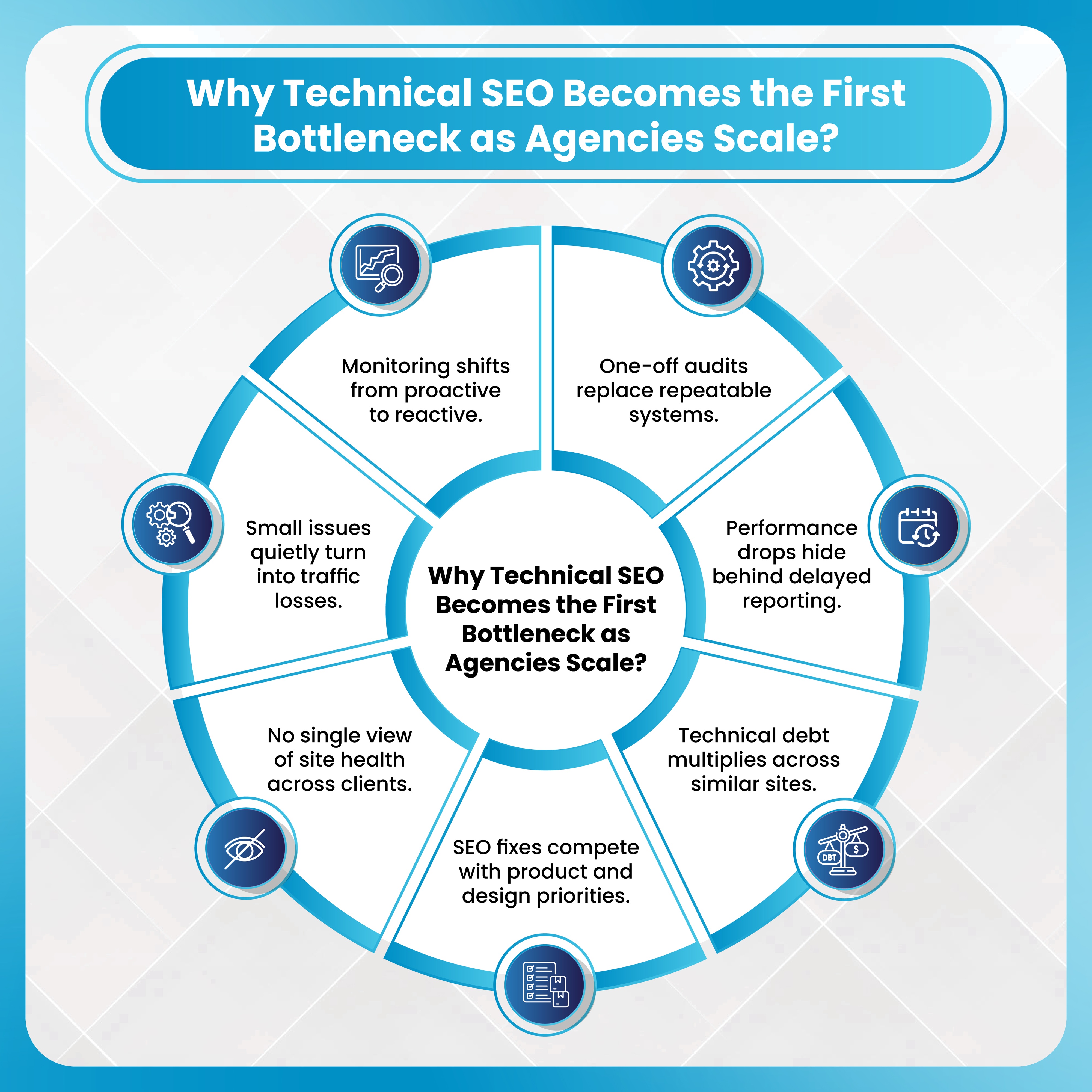
Without this foundation, scaling technical SEO relies too heavily on individual expertise. That approach can work for a while, but it becomes fragile as the agency grows and client expectations rise.
How White Label SEO Partners Solve Scale Problems?
A white label SEO partner provides the structure, tools, and execution needed to handle technical SEO as an operational system rather than a series of one-off tasks.
1. Operational Models and Engagement Types
White label SEO services typically offer flexible engagement models to match agency needs. These include ongoing retainers for technical support, one-time audits with remediation, migration projects, and monthly site care packages.
The white label promise includes rebrandable reporting, dedicated technical leads, and predefined service level agreements for response times. For example, a monthly site health care package may include automated scans, issue triage within 48 hours, and a prioritized fix roadmap.
This allows agencies to deliver consistent technical outcomes without building large internal teams.
2. Scalable Monitoring and Alerting Foundations
A strong white label SEO agency centralizes monitoring across all client sites. Instead of logging into multiple tools, agencies get a single view of site health.
Automated crawls run daily or weekly, Core Web Vitals are monitored using real user metrics, and uptime or speed alerts trigger immediate action. Issues are converted into tickets and prioritized automatically.
Key performance indicators include site health percentage, time to detect issues, and time to resolve them. Semrush site health scores provide a standardized way to measure progress.
3. Repeatable Audit and Remediation Playbooks
White label SEO services rely on standardized audit frameworks. These cover crawling, indexing issues, Core Web Vitals, structured data, redirects, canonicals, hreflang, and server configurations.
Playbooks are built for common platforms like WordPress, Shopify, Magento, and modern JavaScript frameworks. Issues are prioritized into clear categories, making execution faster and more predictable.
Deliverables often include remediation tickets, code-ready recommendations, and quality assurance checklists. For example, faceted navigation issues are handled through proven canonical and parameter strategies.
4. Performance Engineering at Scale
Improving performance across many sites requires templated solutions. White label SEO partner implements image optimization pipelines, critical CSS strategies, caching rules, and CDN configurations at scale.
Performance fixes are often integrated into deployment workflows, ensuring improvements persist after updates. Google Core Web Vitals metrics provide a clear way to measure success. Reducing Largest Contentful Paint or layout shifts improves both user experience and conversion potential.
5. Indexation and Crawl Budget Management
Large sites often waste crawl budget on low-value URLs. White label SEO agencies manage indexation through dynamic sitemaps, robots directives, canonical strategies, and internal linking improvements.
Monthly crawl efficiency reports highlight which pages deserve priority. Success is measured through indexed page quality, crawl frequency, and impressions per indexed URL. These improvements help search engines focus on pages that drive real business value.
6. Structured Data at Scale
Deploying structured data manually across thousands of pages is not practical. White label SEO services use templated JSON-LD implementations with automated validation.
Correct schema improves eligibility for rich results, which can increase visibility and click-through rates. This ties back to the importance of organic traffic highlighted by BrightEdge data. Ecommerce sites benefit from automated product schema applied consistently across catalogs.
7. Migrations, Launches, and Quality Assurance
Migrations are high-risk moments for SEO. White label partners manage pre-launch audits, redirect mapping, and crawl comparisons. Launch-day runbooks ensure fast response if issues appear. Post-launch monitoring tracks indexing and impressions during the critical first 30 days.
Metrics such as indexed page retention and traffic recovery speed help agencies prove success.
8. Reporting, SLAs, and White-Label Dashboards
Agencies need clear, client-ready reporting. White label SEO agency provides branded dashboards, scheduled reports, and weekly technical summaries.
Key metrics include site health scores, Core Web Vitals trends, errors fixed, pages indexed, and organic impression changes. Semrush site health remains a standard KPI for tracking technical progress.

At scale, technical SEO becomes an operational challenge. White label SEO services give agencies the systems and execution needed to maintain site health while focusing on growth.
How DashClicks’ White Label SEO Services Support Technical SEO at Scale?
DashClicks is built to help agencies manage technical SEO efficiently across growing client portfolios. Its white label SEO services focus on scalability, consistency, and transparency.
Their services include structured site health monitoring, technical audits, and ongoing fixes designed to protect performance as client numbers increase. Agencies gain access to standardized workflows that reduce manual effort and speed up issue resolution.
One of the key strengths of their platform is its white-labeled reporting. Technical progress is easy to communicate through branded dashboards and clear summaries, helping agencies demonstrate value without overwhelming clients with complexity.
By partnering with DashClicks, agencies can deliver reliable technical SEO outcomes without expanding in-house teams. This allows account managers and strategists to focus on planning and growth, while technical execution runs smoothly in the background.
Conclusion
Technical SEO at scale is not just about rankings. It is about systems, processes, and reliable execution across many websites. As client portfolios grow, manual approaches break down, and risks increase.
White label SEO partners provide agencies with the tools, expertise, and structure needed to protect site health consistently. From monitoring and performance optimization to migrations and reporting, these partnerships turn technical SEO into a repeatable operation.
Agencies looking to scale should review their current site health processes and identify gaps in monitoring, remediation, and reporting. Piloting a white label SEO agency with clear SLAs and measurable outcomes is often the fastest way to improve reliability without adding internal complexity.
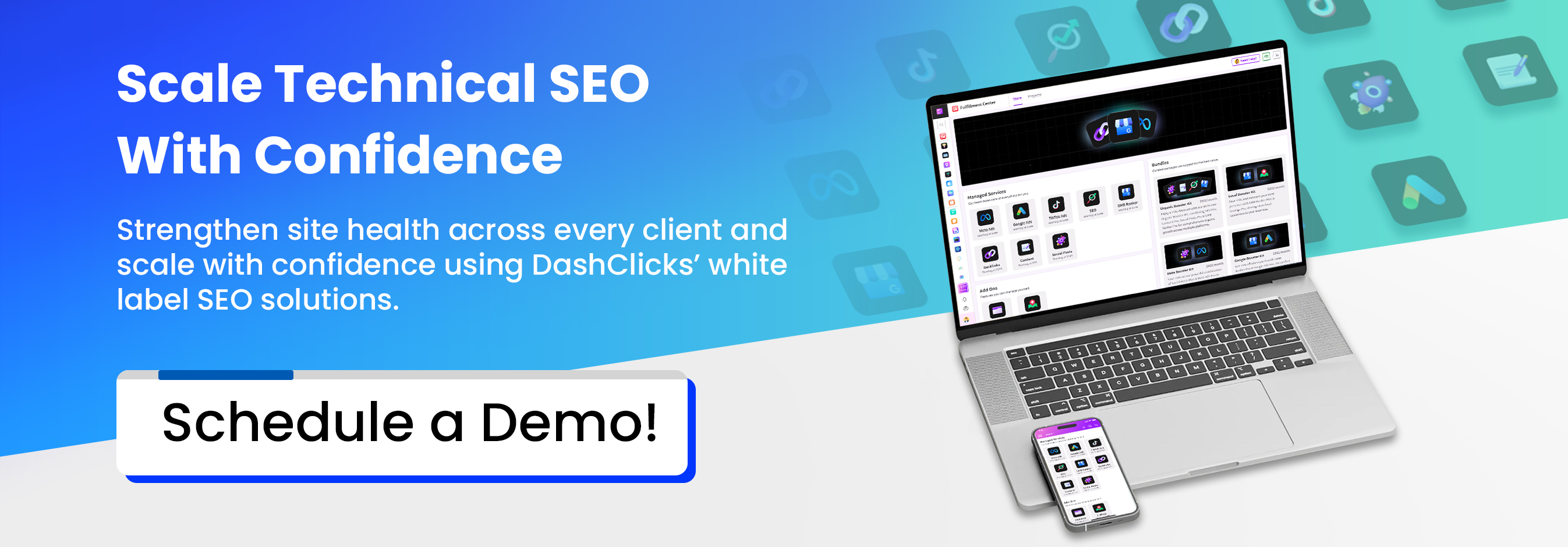

How White Label PPC Removes Marketing Headaches and Boosts ROI
Agencies today face more pressure than ever to deliver strong, measurable results in paid advertising. Teams are stretched thin, ad platforms keep changing, and rising costs make every click more expensive to win. Many agencies want to scale, but they feel limited by staffing, expertise, or operational bandwidth, which makes PPC one of the toughest services to manage consistently.
Recent numbers highlight the reality. More than 60% of agencies rely on outsourcing to scale PPC effectively, according to Amra and Elma LLC. The average Google Ads conversion rate for search campaigns sits around 3.75%, based on WordStream benchmarks. And with the average cost per click in the United States climbing to $4.18 in 2024, as reported by DigitalPosition, agencies have to be more efficient than ever to maintain healthy margins.
This has pushed more agencies toward white label PPC. The promise is simple: eliminate the bottlenecks that slow growth and hand PPC fulfillment to specialists who do it all day, every day. In this blog, you'll learn how white label PPC solves major operational headaches, strengthens ROI, and gives agencies a scalable fulfillment engine without the burden of building an in-house PPC department.
6 Core Marketing Headaches Agencies Face
1. Limited Senior PPC Expertise and Skill Gaps
Many agencies rely on junior PPC staff who are still learning the complexities of bid strategies, keyword intent, audience segmentation, and conversion tracking. Even one misstep—bidding on broad terms, ignoring negative keywords, or misaligning landing pages—can raise costs fast.
When the average conversion rate is 3.75%, every wasted click pushes CPA up. Agencies without senior oversight often struggle to maintain healthy Quality Scores or consistent ROAS. This leads to inflated acquisition costs and inconsistent performance across campaigns.
Skill gaps can also slow response time when the algorithm shifts or when performance dips. Without deep platform knowledge, it becomes harder to diagnose issues, run efficient tests, or scale what works.
2. High Cost and Time Required to Hire, Train, and Retain PPC Talent
Recruiting experienced PPC talent has become expensive and time-consuming. Agencies must compete with in-house brands, marketing firms, and tech companies that offer higher salaries and faster growth prospects. Beyond recruitment, costs include:
- Ongoing training for platform updates.
- Subscriptions to advanced PPC tools.
- Salary benchmarks that rise annually.
Industry reports show that outsourcing certain digital functions can reduce overhead by up to 60%, according to ERVL. For many agencies, running PPC in-house simply isn’t sustainable unless they maintain a large book of clients.
Keeping talent is equally difficult. High turnover pulls teams into a cycle of repeated training, knowledge loss, and unstable client delivery.
3. Scaling Constraints During Growth or Seasonal Spikes
Many agencies hit a ceiling when they try to scale PPC services. Teams get overwhelmed, onboarding takes longer, and the quality of campaign oversight drops. Seasonal spikes—like the holiday rush or specific industry cycles—add even more pressure.
Agencies often face a tough choice: turn away new clients or overload their team. Both options limit growth. A common scenario is an agency missing a large opportunity because they don’t have the bandwidth to launch and optimize campaigns quickly.
Without flexible capacity, agencies struggle to maintain SLAs, deliver fast optimizations, and support high-value accounts that require detailed attention.
4. Tooling and Data Access Gaps
Running PPC at a professional level takes more than tactical knowledge. It depends heavily on having access to the right tools. Modern ad platforms have become more automated, but real performance gains still come from using specialized software that adds deeper insights, faster testing, and stronger attribution. The challenge is that many of these tools are priced for large agencies or enterprise brands, which puts smaller firms at a disadvantage.
Agencies that manage PPC in-house often run into cost barriers when looking for advanced bid automation tools. These platforms analyze thousands of data points in real time, adjust bids across devices and audiences, and react to changing auction conditions faster than manual management ever could. The same applies to audience modeling tools, which help identify high-value segments, create lookalike audiences, and build predictive targeting models that improve ROAS.
Conversion tracking is another area where agencies frequently struggle. Proper attribution requires connectors, tag managers, server-side tracking, and integrations with CRM or sales systems. Without them, it’s hard to understand which interactions actually contribute to conversions or revenue. Landing page testing tools also play an important role. They let teams test headlines, layouts, and calls to action, helping improve conversion rate without increasing ad spend.
Some of the essential tools include:
- Bid management platforms
- Automation scripts
- Landing page testing tools
- Attribution connectors
- Real-time reporting dashboards
Without access to these systems, agencies fall back on manual work. This slows decision-making, increases the risk of errors, and leads to inconsistent optimization cycles. It also creates gaps in reporting because teams don’t have enough data to show how campaigns influence revenue. Incomplete attribution makes it harder to justify budgets, defend performance, or identify the best-performing channels. When agencies can’t connect the dots between spend and results, it limits how confidently they can scale PPC for their clients.
5. Inconsistent Reporting and Difficulty Proving ROI
Clients want clear, transparent reporting that ties ad spend to actual business results. Many agencies struggle because they don’t have a unified system for tracking:
- Conversions
- Revenue attribution
- Cross-channel behavior
- Lead quality
- Long-term ROI
When reports lack structure or consistency, clients question performance—even if the campaigns are working. Missed or inaccurate reporting can lead to churn, reduced trust, and constant pressure to “show results faster.”
6. Margin Squeeze from Rising Media Costs
With CPCs rising year over year, agencies feel pressure from both sides. Clients expect stronger results, but budgets often stay the same. When CPC jumps to $4.18 or more in competitive niches, profit margins tighten.
If campaigns aren’t optimized at every level—audience, creative, bidding, landing pages—profitability suffers. Agencies end up doing more work for less revenue, especially if they rely solely on fixed retainers.
This combination of rising media costs and client expectations creates a long-term margin squeeze that’s difficult to escape without expert support.
Here’s the good news: white label PPC removes each of these headaches and gives agencies a scalable fulfillment engine built for growth.
How White Label PPC Removes Each Headache and Boosts ROI?
White label PPC turns complex ad operations into a repeatable system. By handling execution, optimization, and reporting behind the scenes, it removes common agency bottlenecks while improving ROI across client accounts.
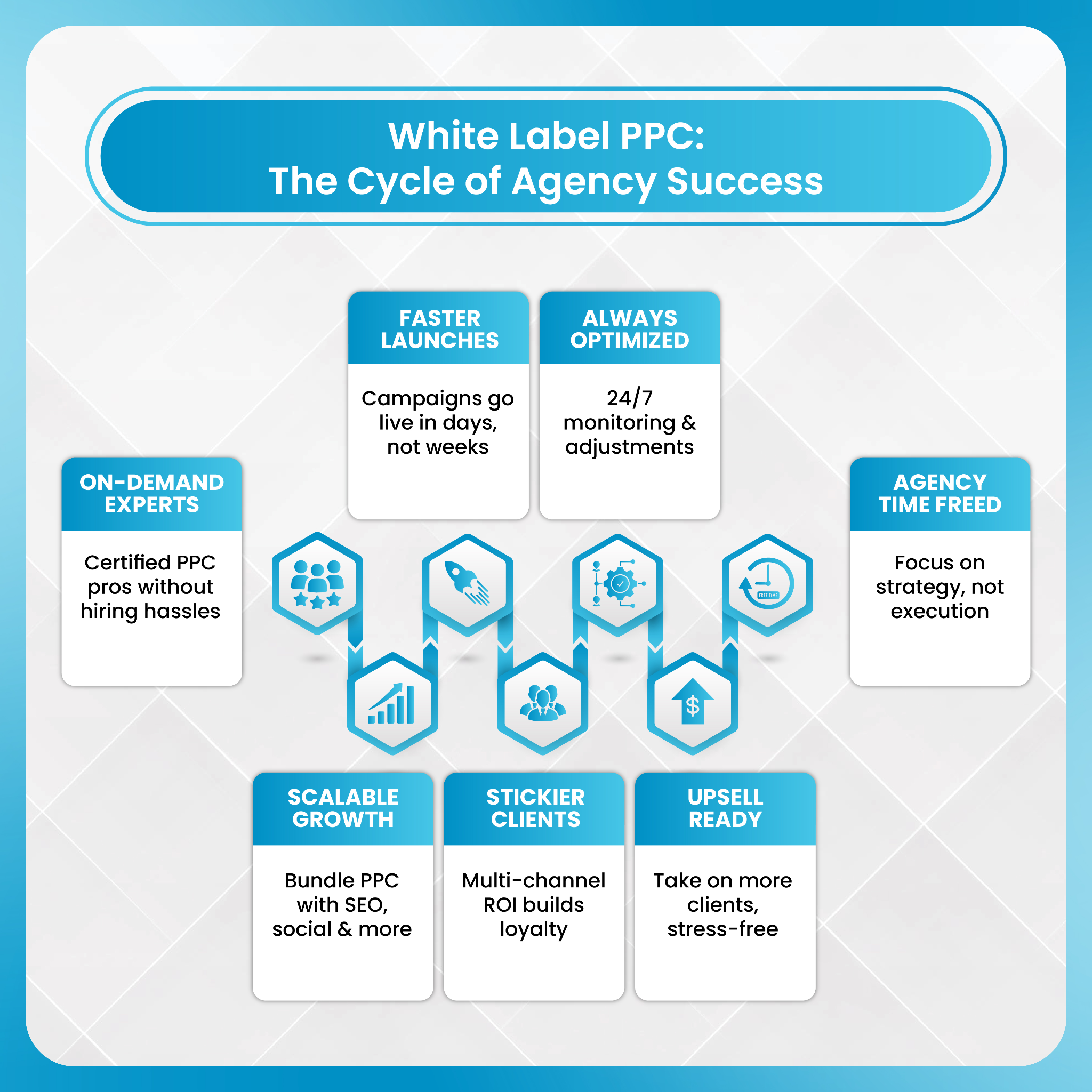
Here is how white label PPC services help agencies -
1. Expert-Led Account Ownership to Solve Skill Gaps
White label PPC agency brings senior-level strategists, paid media specialists, and long-time PPC managers who focus solely on driving performance. This means faster troubleshooting, smarter bidding decisions, and better alignment between landing pages and ad structure.
Expert partners optimize Quality Score, refine targeting, and adjust bidding strategies quickly. The result is stronger performance across all metrics—CPC, CPA, conversion rates, and ROAS. Many agencies experience noticeable improvements within the first 60–90 days.
Because white label PPC providers rely on specialization, they understand the nuances of each platform. Their results are their reputation, which means they’re highly incentivized to deliver measurable improvements.
2. Lower Hiring Costs Through Predictable, Variable Pricing
Instead of paying salaries, benefits, training, and tools, agencies pay only for the PPC accounts they need fulfilled. Pricing structures usually follow models such as:
- Flat monthly fee per account
- Tier-based pricing
- Percentage of ad spend
This shifts a large fixed cost into a flexible variable cost. Agencies improve profit margins because they can mark up white label PPC fulfillment and expand PPC offerings without expanding payroll.
Research shows that outsourcing specialized services can help agencies cut operational expenses significantly, often by up to 60%, based on ERVL data.
Offering PPC often boosts average client revenue by 25–40%, which gives agencies a dependable way to increase recurring revenue without stretching internal resources.
3. On-Demand Scalability and Faster Time-to-Market
White label PPC services help agencies scale immediately. Whether an agency signs a new account or sees a seasonal spike, the partner provides:
- Fast onboarding
- Instant access to extra capacity
- Support for large or complex accounts
There is no need to pause growth, hire new staff, or delay launches. Agencies can say yes to bigger opportunities and maintain strong SLAs. This flexibility is especially important for agencies targeting industries with predictable peaks, such as e-commerce, home services, and healthcare.
4. Enterprise Tools and Unified Attribution Without Extra Cost
White label PPC partners invest in advanced tools that improve campaign performance, including:
- Automated bidding platforms
- Conversion tracking systems
- Multi-touch attribution models
- CRO insights and testing frameworks
- Real-time dashboards
Access to these tools improves optimization cycles and reduces manual work. Agencies gain clearer visibility into the full customer journey, which helps demonstrate ROI more effectively.
These systems also unify data across Google, Meta, and other platforms, so teams can see performance trends without switching between multiple tools.
5. Consistent, White-Labeled Reporting That Builds Client Trust
White label PPC providers deliver structured reports with clear KPIs, such as:
- Impressions
- Click-through Rate
- CPC
- Conversion Rate
- CPA
- ROAS
- Revenue Impact
- Lead Quality
- LTV of Acquired Customers
These reports give agencies a professional, branded way to communicate results. Clients gain transparency into their campaigns, which strengthens trust and reduces churn.
A standard reporting cadence includes:
- Weekly performance snapshots
- Monthly executive summaries
- Quarterly strategy reviews
Structured reporting makes client conversations easier, more productive, and more strategic.

6. Efficiency-Driven Optimization to Offset Rising CPCs
As CPCs rise, the only way to protect margins is to improve efficiency. White label PPC teams apply advanced tactics, including:
- Audience refinement
- Aggressive negative keyword management
- Smart Bidding with expert oversight
- A/B testing for creatives and landing pages
- CRO-driven adjustments
- High-intent keyword prioritization
- Remarketing funnels
When conversion rates rise—even slightly—it helps offset rising CPCs. For example, a small increase from 3.75% to 5% can dramatically lower CPA and raise ROAS. These improvements make PPC sustainable even when costs increase across industries.
Measurable KPIs and Reporting Cadence Agencies Should Expect
A strong white label PPC partner should provide clear KPIs that reflect both performance and revenue impact. Key metrics include:
- Conversion Rate: baselines around 3.75% for search
- CPC: compare against the US average of $4.18
- CPA: cost required to acquire a new lead or customer
- ROAS: revenue generated for each dollar spent
- LTV-to-CAC Ratio: long-term profitability
- Impression Share: visibility compared to competitors
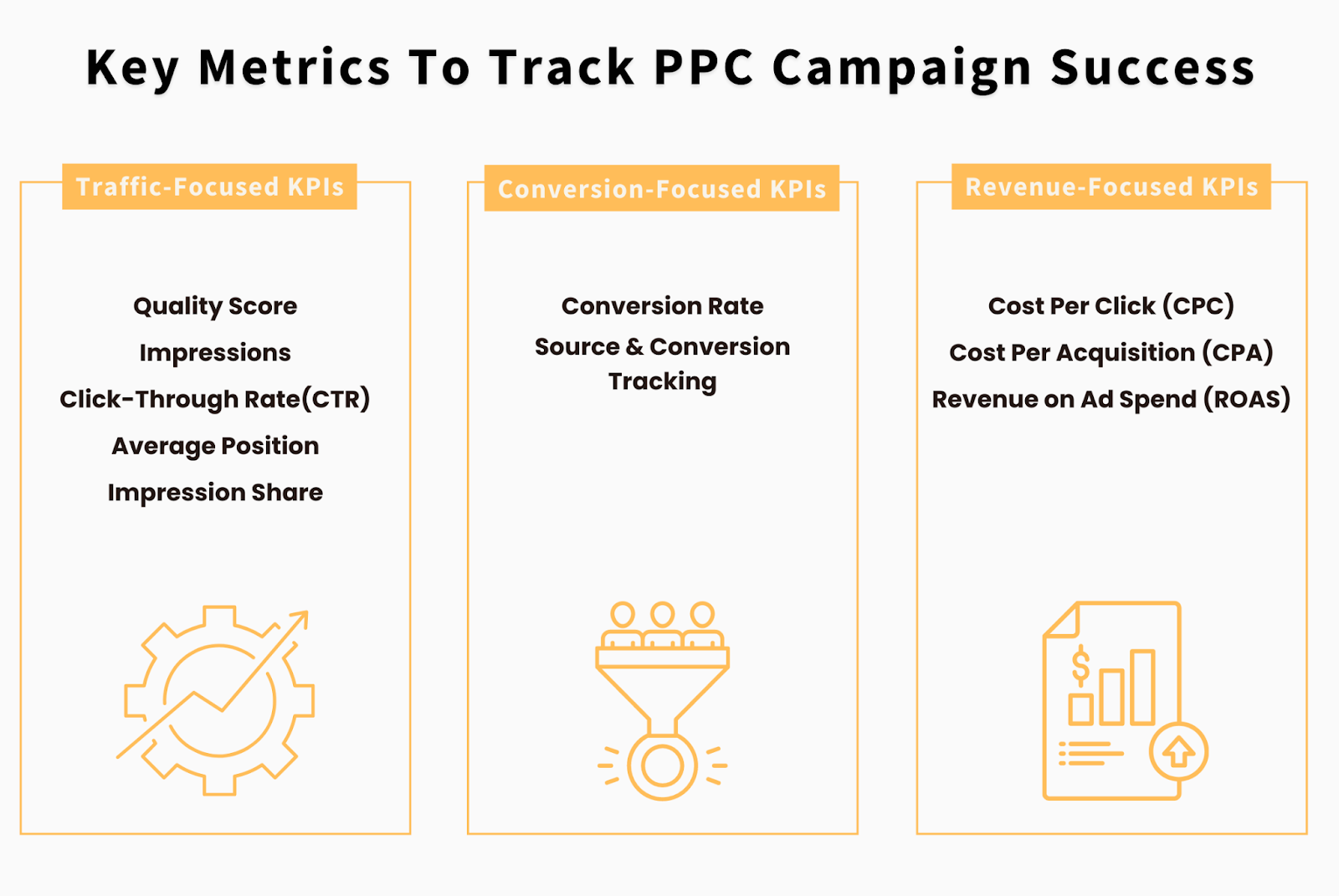
The recommended reporting cadence includes:
- Weekly operational reports for optimization insights.
- Monthly executive summaries that highlight revenue, lead quality, and attribution.
- Quarterly reviews that include strategy shifts, seasonal planning, and budget opportunities.
A simple reporting layout includes columns for KPI, current period, previous period, and period-over-period variance. This helps clients see trends clearly and understand what’s improving.
How to Choose the Right White Label PPC Partner?
A dependable partner should meet several criteria before you trust them with your clients. Look for:
- Certifications and proven case studies with clear performance improvements.
- GA4 integration, server-side tracking, and platform expertise.
- Transparent SLAs and reporting structure.
- Flexible pricing with room to mark up for healthy margins.
- Fast onboarding and the option for a trial audit.
Red flags include:
- Vague or incomplete reporting.
- No clear onboarding timeline.
- Lack of performance guarantees.
- Long-term lock-in contracts.
- No visibility into optimization processes.
Choosing the right partner ensures your agency can scale confidently without sacrificing quality.
How DashClicks Helps Agencies Remove PPC Headaches and Boost ROI?
DashClicks provides complete white label PPC services designed specifically for agencies that want to scale without taking on more operational work. Their fulfillment team is staffed with senior-level PPC strategists who manage everything from campaign setup to optimization and reporting. This allows agencies to deliver expert-level PPC without hiring specialists internally.
DashClicks manages full campaign builds across Google and Meta, handles tracking setup with GA4, pixel installation, and event configuration, and performs weekly optimizations that include bid adjustments, creative testing, keyword refinement, and landing page recommendations. Their real-time white-labeled dashboards give agencies transparent reporting that clients can access anytime.
One of the biggest benefits is scalability. Agencies can onboard unlimited PPC clients without expanding their internal team. DashClicks offers predictable, margin-friendly pricing that agencies can easily mark up, helping them increase recurring revenue while reducing overhead. Their support team ensures smooth onboarding and fulfillment consistency, which makes it easy for agencies to grow their PPC offerings without the stress of managing everything in-house.
Wrap-Up
White label PPC gives agencies a reliable way to eliminate operational challenges and improve ROI for their clients. It removes talent shortages, reduces overhead, improves reporting, and provides scalability without the risk of hiring. With rising CPCs and client expectations, agencies need stronger optimization and clear attribution to remain competitive—white label PPC delivers both.

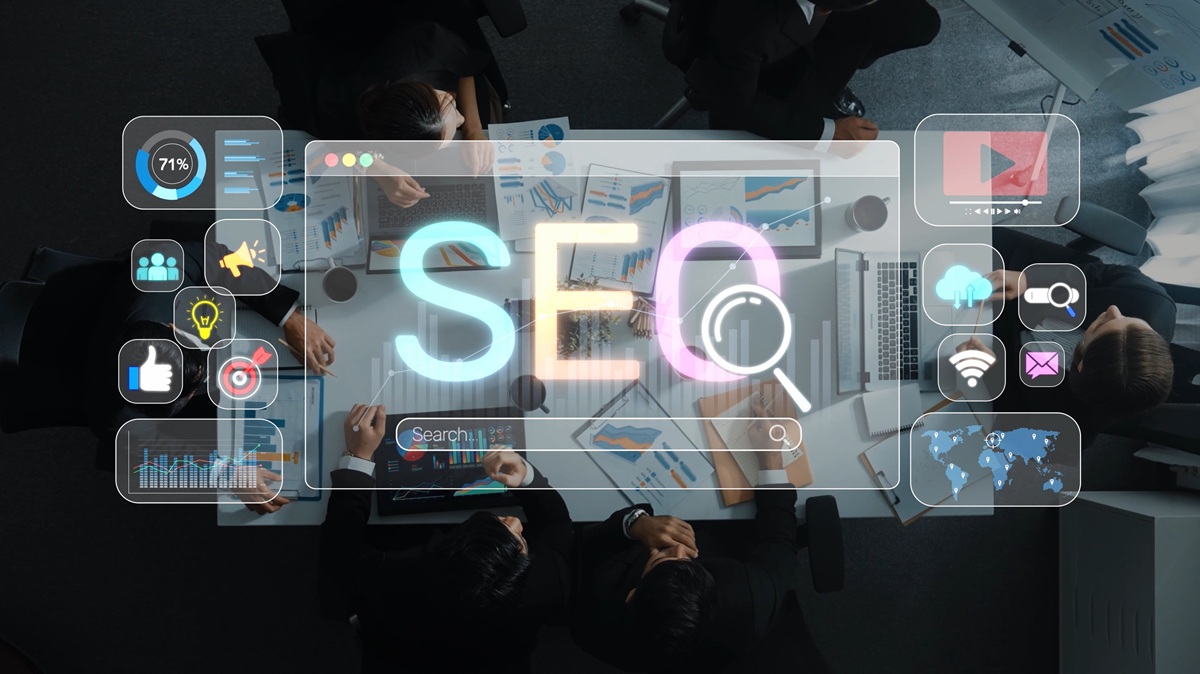
Beyond Rankings: Advanced KPIs to Track in White Label SEO Campaigns
Search engine rankings feel great — nothing signals success quite like seeing a client’s website move up to page one. But if you care about long-term success and real business impact, rankings are only the beginning. For agencies working with white label SEO partners, it’s essential to track deeper, more meaningful performance metrics. These advanced indicators show what really matters: traffic, engagement, conversions, and client satisfaction.
In this post, we’ll explore the most powerful metrics to measure beyond keyword positions, explain why they matter, and show how a white label SEO partner helps agencies deliver those results under their own brand.
Why “Beyond Rankings” Matters?
Many agencies stop at “we moved the site up on Google.” But for a business paying for SEO, what truly counts is what happens after users find their site. Think about it:
- A top-ranking page that gets no clicks adds little value.
- A site with high bounce rates wastes traffic.
- Page one rankings don’t guarantee conversions or revenue.
Focusing on advanced KPIs aligns your SEO program with real business goals — leads, sales, and retention. It improves transparency, trust, and long-term client satisfaction.
Plus, it gives you data to show return on investment (ROI). This matters especially when you’re reselling white label SEO: your clients expect more than just vanity metrics.
Advanced KPIs to Measure
Here’s a deeper look at useful KPIs beyond rankings and what they reveal about the overall health of an SEO campaign.
1. Organic Traffic and New Users
Looking at total organic traffic and the number of new users helps you see how many people are discovering your client’s site through search. These numbers tell you whether visibility is improving and whether your content is reaching the right audience.
Total organic sessions reflect search-driven volume. When this trend increases over several months, it usually shows stronger visibility, better search presence, and content that aligns with what users want.
The ratio of new vs returning organic users adds more context. High new-user numbers indicate your SEO is reaching new audiences and expanding the client’s presence. If the majority of traffic consists of returning visitors, it may signal the need to broaden keyword targeting, publish new content types, or explore untapped search opportunities.
Why it matters: Traffic opens the door to conversions and sales. High rankings only matter if people are actually visiting the site.
2. Click-Through Rate (CTR) from Search Results
Click-through rate measures how many people who see your page in search results actually click on it. It’s one of the fastest ways to understand whether your titles and descriptions are compelling.
A solid CTR (often somewhere between 3 and 10 percent depending on competition and intent) usually shows that your title tags, meta descriptions, and snippets match what users are looking for.
If you see strong rankings paired with a weak CTR, that’s a sign to improve meta tags, enhance schema markup for better rich snippets, or revise content to better match search intent. Even small adjustments can make a noticeable impact.
A healthy CTR ensures your visibility turns into website visits instead of impressions that go to waste.
3. Bounce Rate and Dwell Time / Session Duration
These engagement metrics help you understand how visitors interact with your site once they arrive.
Bounce rate measures how many people leave after viewing only one page. A high bounce rate often means the content, layout, or loading experience didn’t meet their expectations. It can also point to mismatched keywords or vague headlines that attract the wrong audience.
Average session duration and pages per session offer more insight into engagement. Longer sessions and multiple page views usually mean your content aligns with user intent, answers key questions, and encourages people to explore further.
Tracking bounce rate and engagement over time helps you refine navigation, page speed, structure, and content depth so visitors stay longer and get more value from the site.
4. Conversion Rate (CVR) and Goal Completions
The real purpose of SEO isn’t just visibility. It’s an action. Whether that’s booking an appointment, completing a purchase, filling out a form, or signing up for a newsletter, conversions are what clients care about.
Conversion rate measures how well organic traffic turns into meaningful actions. Tracking CVR over time shows whether your SEO work is attracting qualified visitors who are ready to move forward.
Goal completions reflect the actual number of leads, sign-ups, downloads, or purchases. They give you a clear view of the value your SEO work delivers instead of relying only on traffic trends.
For many businesses, these numbers hold more weight than rankings or impressions because they directly affect revenue.
Further Reading: Conversion Rate Optimization (CRO): 8 Ways to Get Started
5. Return on Investment (ROI) and Cost per Acquisition (CPA)
If you know how many organic conversions occurred and the average value of each customer, you can start calculating financial performance, which is essential for long-term planning.
Cost per acquisition shows how much it costs to secure a lead or customer through SEO efforts. If CPA drops over time, it’s a sign the campaign is becoming more efficient.
ROI helps you understand whether the client’s SEO investment is paying off. Showing that organic search contributes more revenue than it costs is one of the most powerful ways to reinforce the value of ongoing SEO.
These financial KPIs help agencies demonstrate transparency, justify budgets, and make smarter decisions about where to invest next.
6. Backlinks & Referring Domains Quality
SEO still depends significantly on off-site signals. But instead of just counting backlinks, focus on quality and relevance:
- Number of new referring domains (especially authoritative ones).
- Domain authority or trust metrics.
- Ratio of do-follow to no-follow links (depending on strategy).
Quality backlinks improve authority and long-term ranking stability.
7. Page Speed & Core Web Vitals
User experience matters. Search engines — and users — increasingly value performance.
- Measure page load times, First Contentful Paint (FCP), Largest Contentful Paint (LCP), and Cumulative Layout Shift (CLS).
- Fast, stable pages reduce bounce and improve engagement, especially on mobile.
With mobile traffic now dominating global web usage, performance matters more than ever.
8. Local SEO Signals
For local businesses, these matter a lot:
- Consistency of business listings and citations (Name, Address, Phone).
- Reviews and review growth rate.
- Local search traffic and conversions.
Measuring these helps build visibility for local queries and drives real customers through the door.
9. Content Engagement & Quality Signals
When your campaign includes content marketing (blogs, articles, guides), these metrics reveal its impact:
- Shares, social engagement, time on page — show how valuable the content is to readers.
- New organic keywords discovered per piece of content — indicates content is ranking for long-tail queries over time.
- Internal link performance — which pages keep users engaged and reduce bounce.
Strong content performance strengthens your site for long-term growth.

Image Source: Medium
How DashClicks Makes Tracking Advanced KPIs Easy for Agencies?
DashClicks offers fully white label SEO services along with a unified dashboard, which simplifies tracking and reporting on advanced KPIs. Here’s how it fits in with the advanced KPI approach:
- DashClicks handles essentials like technical audits, content optimization, link-building, and page-speed improvements, ensuring the technical and SEO foundations are strong.
- Through its dashboard, agencies get real-time reports — showing organic traffic, conversions, backlink growth, and site performance — all under their own brand.
- Agencies don’t need to buy expensive tools like SEMrush or Ahrefs on their own. DashClicks gives access to data-driven SEO analytics through its fulfillment model.
- The scalable, white-label model lets agencies handle many clients with predictable workflows while delivering consistent, quality SEO results — making it easier to track KPIs across multiple client campaigns without chaos.
In short, DashClicks helps you go beyond just monitoring “Where do we rank?” — you can show clients the full picture: traffic, engagement, conversions, and value.
Best Practices for Measuring Advanced SEO KPIs
- To get the most value from your tracking and reporting, it helps to follow a consistent approach that keeps data accurate, meaningful, and easy for clients to understand.
- Set clear baseline data at the start. Before making any optimization changes, record current traffic levels, conversion counts, bounce rates, engagement metrics, and ranking positions. Baseline data gives you a reliable point of comparison and makes it easier to show progress over time.
- Segment data by traffic source and device. Breaking down organic, paid, referral, direct, and social performance highlights how each channel contributes to growth. Device segmentation helps you see whether mobile users behave differently from desktop visitors, which can uncover UX issues or content gaps.
- Use conversion tracking and goals in your analytics setup. Make sure every important action is being tracked correctly, whether it’s a form submission, phone call, purchase, download, or time-based goal. Without clean tracking, it’s impossible to evaluate the quality of organic traffic or understand what’s driving results.
- Report on a regular schedule, either monthly or quarterly. Consistent reporting helps you identify patterns, seasonal trends, early warning signs, or sudden drops that need attention. It also allows you to communicate progress in a clear and timely way.
- Compare metrics over meaningful periods, not just month to month. Month-to-month shifts can be noisy due to holidays, algorithm updates, or natural fluctuations. Quarterly or year-over-year comparisons give you a more stable view of long-term progress.
- Communicate KPIs in a way clients can easily understand. Go beyond numbers by explaining what each metric means and why it matters. Help clients see that rankings or traffic growth are valuable, but engagement and conversions are stronger indicators of real performance. Clear explanations make it easier for clients to appreciate the full impact of your SEO work.
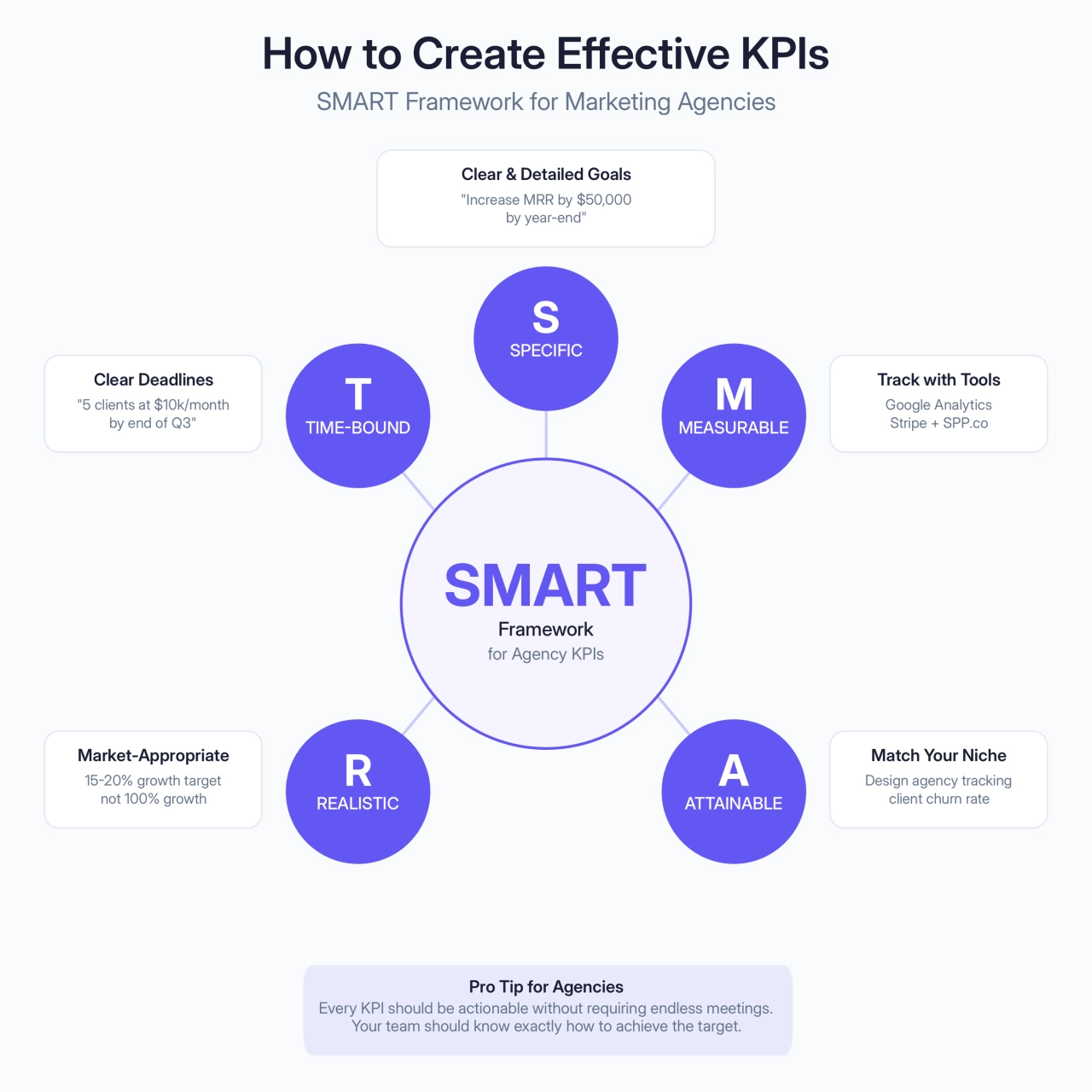
Image Source: Service Provider Pro
Why Advanced KPIs Matter More Now Than Ever?
SEO has evolved. Algorithms constantly shift. User expectations have risen. Here’s why deeper KPIs matter more than ever:
- Search engines now reward page experience, mobile performance, and user engagement — not just backlinks or content.
- With more content online than ever, competition is fierce. Quality, relevance, and user experience make the difference.
- Businesses expect measurable ROI. They want revenue, leads, or real conversions — not just “top 10 ranking.”
- Over time, advanced KPIs help spot problems early: a site might lose conversions even with stable traffic (bad UX or broken links), or gain traffic but lose engagement (weak content).
Challenges and How to Overcome Them?
Measuring advanced KPIs is not without challenges. Here are some common issues:
1. Data Overload — Too many metrics can overwhelm.
Solution: Focus on 4-6 key metrics per client (e.g., organic traffic, conversions, bounce rate, page speed, backlink growth, CTR).
2. Attribution Difficulties — Not all conversions are from organic SEO.
Solution: Use clear tracking (UTM tags, analytics goals) and distinguish organic vs other channels.
3. Slow ROI on SEO — SEO takes time; conversions may lag.
Solution: Set realistic timelines (many campaigns show strong results in 3–6 months) and report interim progress (traffic, engagement).
4. Client Misalignment — Clients may care only about rankings.
Solution: Educate them early about the value of deeper KPIs. Show how rankings + conversions = business growth.
Conclusion
Focusing solely on keyword rankings is like judging a movie by its poster — it gives a hint, but not the full story.
Advanced KPIs reveal what truly matters: whether real people visit the site, stay engaged, convert, and come back. They help you build transparency, trust, and lasting value for your clients.
By tracking metrics like organic traffic, CTR, bounce rate, conversions, backlinks, page speed, and engagement — and by presenting them clearly and regularly — you can transform SEO from a vanity service into a measurable engine for growth.
If you partner with a white label SEO agency like DashClicks, you gain access to tools, data, reporting, and white label dashboards that make advanced KPI tracking effortless and scalable. DashClicks doesn’t just help you hit higher rankings — it helps you deliver real performance, under your brand.
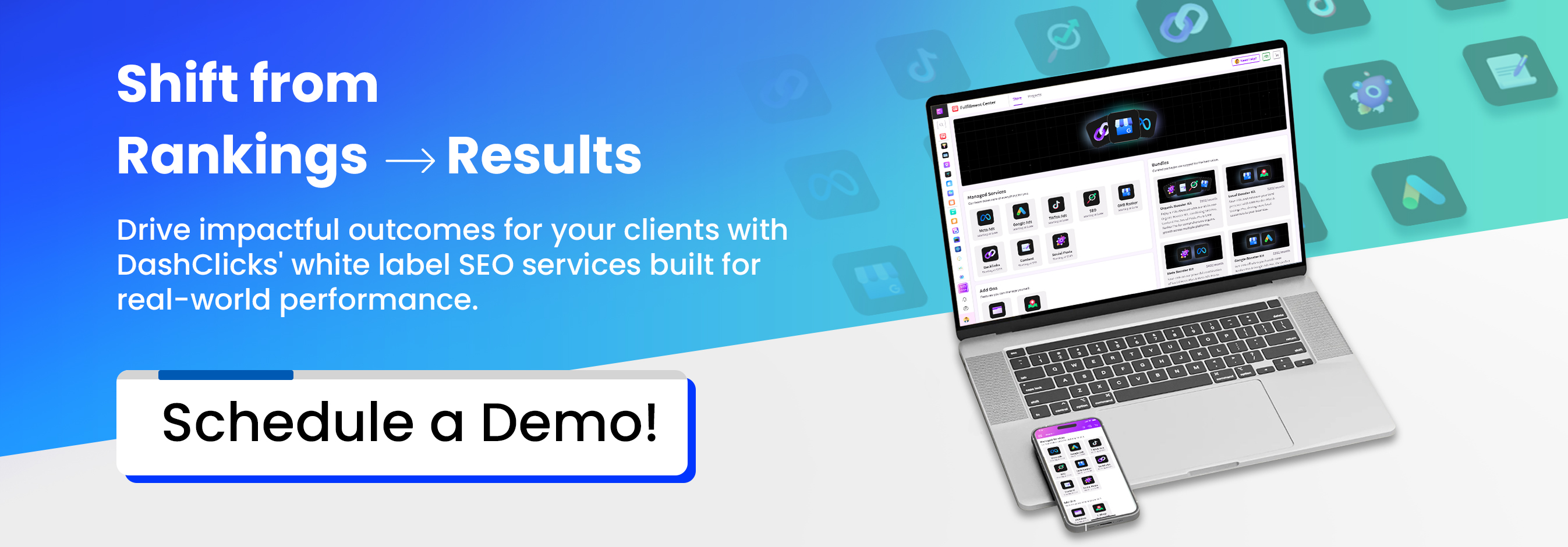
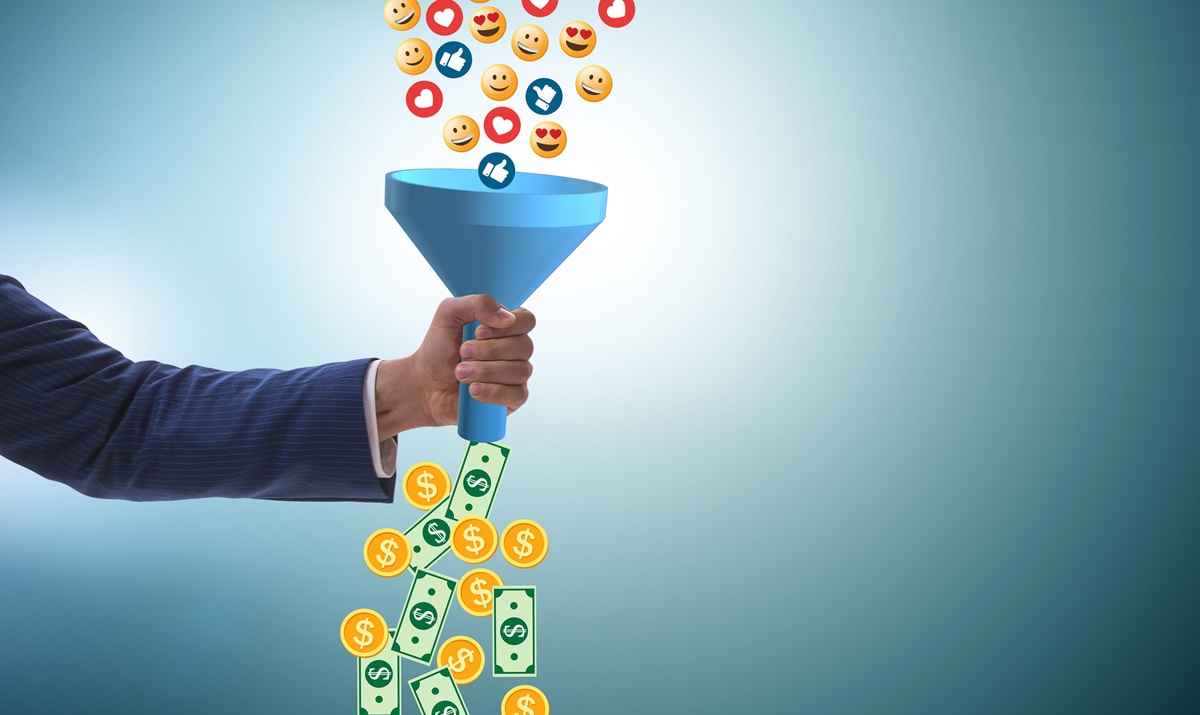
From Clicks to Conversions: How White Label PPC Improves Funnel Performance
Paid advertising continues to be one of the most reliable ways for businesses to create predictable demand. What has changed is the way audiences behave. People move across platforms, consume more content, compare more options, and expect faster, more relevant experiences. At the same time, bidding systems grow more sophisticated, data privacy rules tighten, and cost-per-click increases across competitive verticals. All of this puts more pressure on agencies to manage the entire funnel with greater precision, not just the top of it.
Recent benchmark studies show that average Google Ads conversion rates vary widely by industry. For example, e-commerce search campaigns often hover around 2.8 percent, while blended averages across various sectors have reached roughly 7.5 percent, depending on the account mix. These numbers highlight a simple truth. When campaigns, audiences, and landing pages work together, the gap between a click and a conversion closes fast.
Many agencies know what needs to be done but struggle with capacity, specialist skills, and the ability to run tests at the speed the platforms demand. That’s where white label PPC management becomes a practical solution. More agencies are turning to PPC outsourcing to stay competitive, maintain quality, and keep their clients happy. Industry surveys show continued growth in outsourced paid media support, especially among small to mid-sized agencies.
This guide walks through the real reasons agencies lose conversions and how white label PPC services can improve funnel performance. It’s a tactical playbook, not a sales pitch. You’ll see the roadblocks, the capabilities you should expect, and the systems that turn paid traffic into revenue more consistently.
What Stops Agencies From Converting Clicks Into Predictable Revenue?
Agencies rarely struggle to drive traffic. The real challenge is converting that traffic into qualified leads or sales.
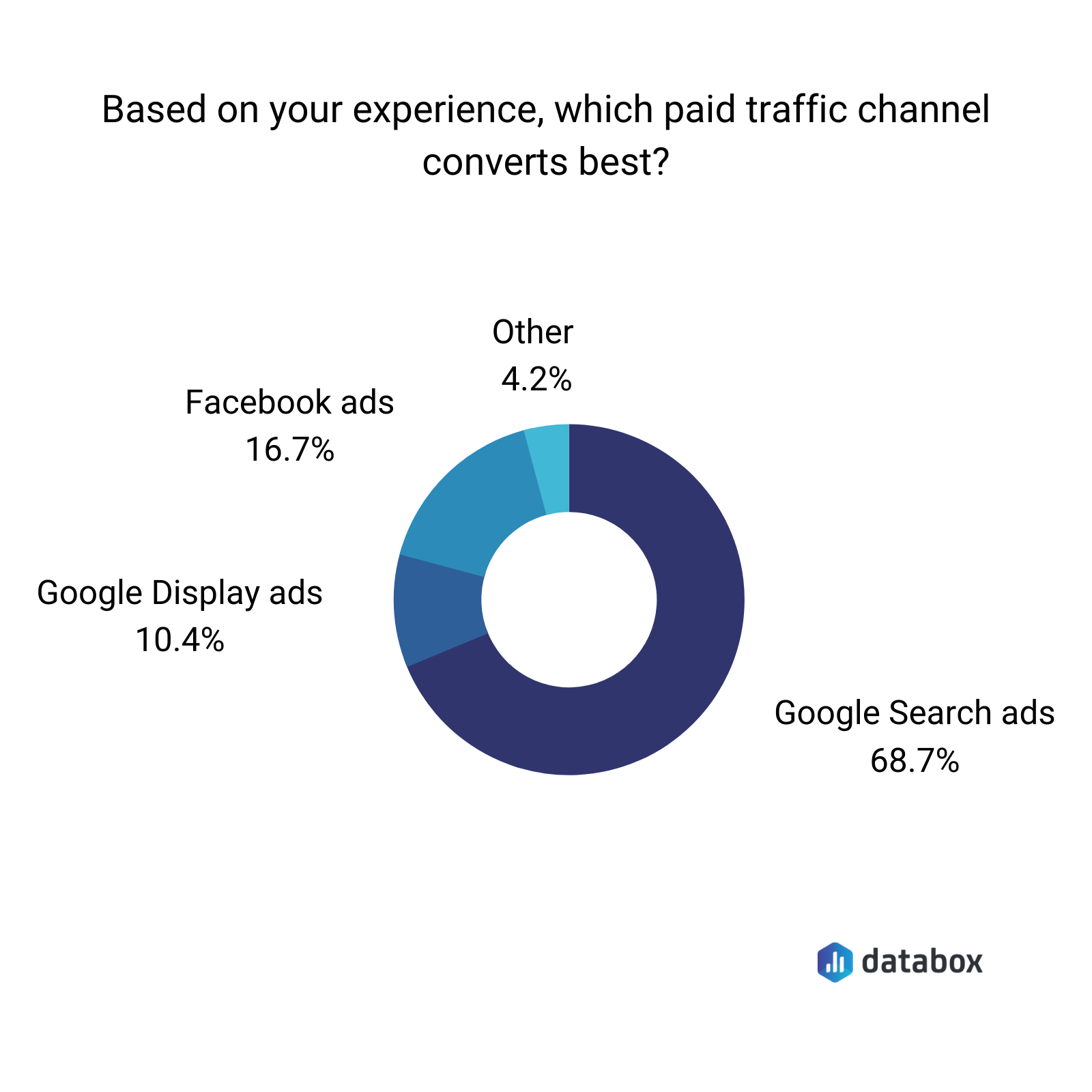
Image Source: Databox
Here are the most common issues that get in the way, along with examples of how they affect performance.
1. Limited Skills and Bandwidth When Scaling
Running high-performing paid campaigns across multiple networks requires different specialists. Search, Shopping, YouTube, Performance Max, Discovery, and retargeting all behave differently. Agencies with small teams can manage a few accounts well, but continuous optimization becomes difficult as the client list grows.
A common symptom is a slow A/B testing cadence. When an agency is stretched thin, creatives stay active for too long, click-through rates decline, and the account loses momentum. Without rapid rotation, quality scores drop, and CPCs climb.
2. Fragmented Workflows Between Campaigns, Landing Pages, and CRO
Many agencies focus heavily on the ad side and leave landing pages, design, and conversion rate optimization to separate teams or freelancers. This disconnect leads to mismatched messaging and poor user experience.
For example, an ad may promise a specific offer, but the landing page might lead with different benefits. Even small inconsistencies cause friction, reducing conversions and increasing bounce rates.
3. Tracking and Attribution Issues
Accurate tracking is a major bottleneck for many agencies. Common issues include:
- Misconfigured conversion actions
- Cross-domain tracking errors
- Missing event parameters
- Lack of server-side tracking
- Gaps in CRM integrations
When conversions are underreported or misattributed, agencies lose visibility into what actually drives results. That makes it hard to optimize, justify budgets, or prove ROI.
4. Slow Experimentation and Learning Cycles
Paid platforms reward advertisers who adapt quickly. When an agency updates ads slowly or tests one variable at a time over long periods, performance stagnates. This is especially painful when CPCs rise.
A slow testing process limits actionable insights, reduces lift, and delays improvements that could lower cost-per-acquisition.
5. Rising CPCs and Margin Pressure
Across many industries, CPCs have increased year over year. Agencies must extract more value from every click to sustain profitability. Without deep optimization and strong landing page performance, rising CPCs erode margins and frustrate clients.
6. Inconsistent Reporting and Misaligned Expectations
Clients don’t want reports full of impressions and clicks. They want clarity on leads, revenue, lifetime value, and return on ad spend. Agencies that provide surface-level dashboards often face churn because clients can’t see the true impact.
Each of these challenges aligns with the capabilities a strong white label PPC partner can provide. The following section breaks down the specific systems agencies should expect from a partner who truly supports full-funnel performance.
How White Label PPC Improves Funnel Performance?
A strong white label PPC partner gives agencies access to specialized skills, faster testing cycles, more accurate tracking, and better reporting. Below are nine tactical capabilities that directly improve funnel results.
1. Full-Funnel Campaign Design
Strong PPC campaigns guide users from first touch to final conversion instead of treating every click the same. A well-built funnel assigns each campaign type to a clear role in the buyer journey. Discovery and YouTube work best for building awareness and introducing your offer to new audiences. Search and Shopping take over when people are actively comparing options and showing high intent. Remarketing steps in when someone is close to making a decision and just needs a final push.
When campaigns line up with user intent, budgets work harder, messaging feels more relevant, and conversion rates usually rise. A good partner will map out a full-funnel plan that outlines audience segments, creative direction, and budget recommendations for each stage so agencies can see exactly how the pieces fit together.
2. Rapid Creative and Copy Rotation
Creative fatigue can set in fast, especially on platforms with heavy impression volume. That’s why high-performing accounts rely on steady creative rotation. A strong partner should be able to produce and test 15 to 30 new ad variations each month for every funnel stage. This pace keeps campaigns fresh and drives steady improvement.
Regular rotation helps maintain healthy click-through rates, supports stronger quality scores, lowers CPCs, and often leads to better conversion performance. Ask for a creative testing log that shows when new ads were launched, how they performed, and which insights came from each round of testing.
3. Post-Click Optimization and CRO Support
A big share of lost conversions happens after the click, not in the ad itself. Landing pages that are slow, cluttered, or unclear make even the strongest campaigns struggle. A partner with dedicated conversion rate optimization expertise can help fix these issues before they hurt performance.
Support should include fast, conversion-focused landing page templates, personalization options that match user intent, structured A/B or multivariate testing, and form improvements that reduce friction. Even small gains in conversion rate add up. A lift of 5 to 15 percent on landing pages can sharply reduce CPA over time. A reliable partner will be able to show past CRO tests and the measurable improvements they produced.
4. Advanced Measurement and Attribution
Accurate tracking is the foundation of effective PPC campaigns for agencies. A solid white label PPC partner should be able to manage server-side setups, build clean GA4 event architecture, configure conversion API integrations, and import CRM or offline conversions. They should also understand how to apply attribution modeling that reflects the full customer journey.
With the right measurement in place, agencies can focus on revenue-driving actions rather than surface-level numbers. A capable partner should be able to share a data architecture outline and a sample attribution model to show how each touchpoint is evaluated.

5. Audience Engineering and Remarketing Structures
Audience structure is one of the biggest levers for improving funnel performance. A strong partner will create layered audience stacks that include engagers, past converters, high-value lookalike groups, and structured sequential remarketing. These layers help connect the right message to the right user at the right time.
When audiences are aligned with intent, ROAS tends to rise naturally because every stage of the funnel becomes more efficient. A good partner should provide a clear target audience taxonomy and rules for how bids and budgets shift based on lifetime value or predicted intent.
6. Cross-Channel Media Coordination
Modern funnels rarely stay within one platform. Users move between search, social, video, and display, so messaging needs to stay consistent across all touchpoints. A reliable white label PPC partner will manage coordinated campaigns across Search, Performance Max, Discovery, YouTube, social retargeting, and Connected TV when it fits the strategy.
Cross-channel alignment shortens the path to purchase, strengthens brand recognition, and can even increase average order value. The goal is to guide users smoothly from first impression to final conversion, no matter where they interact with the brand.
Further Reading: Cross-Channel Marketing: What It Is, Major Benefits + How to Get Started
7. Programmatic Capability and Automation
Automation has become essential for keeping campaigns responsive. A strong partner knows how to use rules-based bidding, automated scripts, portfolio bidding, and programmatic placements to adjust quickly based on performance trends. These tools make campaigns more agile than manual changes alone.
With a proper automation framework, budgets shift toward winning segments faster, wasted spend drops, and overall efficiency improves. It’s reasonable to ask for an automation playbook that outlines how these systems are used and which indicators trigger adjustments.
8. Faster Experimentation and Regular Learning Cycles
High-performing accounts rely on steady testing. A white label PPC partner should run structured experiments each month and supply a testing calendar that shows what’s coming next. Each test should include a clear hypothesis, success benchmarks, and a summary of insights once results come in.
This steady learning cycle helps campaigns improve predictably instead of relying on guesswork. The more consistent the testing rhythm, the more reliable the long-term performance gains.
9. Reporting Built for Conversions
Reports should go beyond surface metrics and focus on what actually impacts revenue. That includes conversion paths, cohort-level CPA, lifetime value trends, incrementality testing, and lead quality indicators. These insights help agencies tell a clearer story about performance and guide better decision-making.
With reporting that highlights true business outcomes, agencies can build stronger client relationships and show a direct link between PPC efforts and growth.

Tactical Playbooks Agencies Can Use Immediately
Here are four quick playbooks agencies can implement with the support of a white label PPC partner.
1. Lower-Funnel CPA Rescue
Goal: Reduce acquisition costs
Tactics:
- Strong remarketing sequences
- Bidding focused on conversion value
- Dynamic search ads
Expected lift: Many accounts see CPA reductions between 15 and 35 percent within two months, depending on industry and volume.
2. Scaling Without Losing Lead or Sales Quality
Goal: Grow spend while maintaining ROAS
Tactics:
- Expand winning creative themes
- Build new lookalike audiences
- Use portfolio bidding strategies
- Run incrementality tests
Expected lift: Agencies often double budgets while stabilizing ROAS through improved targeting and cross-channel reinforcement.
3. Improving Lead Quality for Service Businesses
Goal: Reduce low-quality or unqualified leads
Tactics:
- Post-click form enrichment
- Lead scoring with CRM data
- Offline conversion uploads
- Negative keyword expansion
Expected lift: Higher qualified lead rates and better alignment between marketing and sales.
4. Increasing AOV and CLTV for Ecommerce
Goal: Raise transaction value and repeat purchases
Tactics:
- Bundled or tiered offers
- On-site personalization
- Post-purchase remarketing
- Cart recovery campaigns
Expected lift: Many ecommerce brands see an 8 to 20 percent uplift in average order value when combined with strong paid media and CRO.
Commercial and Operational Considerations for Agencies
Before partnering with a white label PPC services, agencies should think about operational details that protect client trust and preserve margins.
1. Pricing and Margins
Agencies typically choose between:
- Flat monthly retainer
- Percentage of ad spend
- Hybrid model
The right structure depends on client size, niche, and internal processes. Many resell white label PPC under a tiered package structure that includes CRO support and reporting.
2. Service Level Agreements and Workflow
A reliable partner will define:
- Turnaround times for creative and campaign updates
- Reporting schedules
- Escalation paths
- Quality standards
Clear SLAs prevent surprises and maintain consistency across accounts.
3. Data, Access, and Security
Agencies should ensure:
- Secure logins and access controls
- MCC-level management
- Compliance with privacy regulations
- Proper storage and handling of client data
These steps protect both the agency and its customers.
4. Packaging White Label PPC as a Value-Add
A well-designed white label PPC management program helps agencies offer more comprehensive services. Many bundle PPC with CRO, landing pages, analytics support, and content to create stronger recurring revenue.
How DashClicks Helps Agencies Improve Funnel Performance From Clicks to Conversions?
DashClicks provides white label PPC services designed to strengthen funnel performance across every stage, from awareness to decision. The platform combines strategy, execution, and reporting in one system so agencies can offer full-service PPC without hiring new staff. Agencies gain access to specialist teams who build campaigns aligned with user intent, optimize audiences and creative assets continuously, and monitor post-click behavior to improve conversion rates.
DashClicks integrates advanced tracking setups, conversion API support, and CRM connections so attribution remains accurate and transparent. The system also includes client-facing dashboards that highlight key insights such as CPA, ROAS, funnel movement, and lead quality.
With scalable white label support, agencies maintain full ownership of client communication and branding while relying on a dependable backend team to manage execution. This structure helps agencies deliver stronger results, shorten learning cycles, and keep clients satisfied with clear, measurable progress.
A Well-Rounded Ending That Brings It All Together
White label PPC gives agencies a practical way to turn clicks into measurable business outcomes. With rising costs and more complex user journeys, agencies need systems that cover creative testing, landing page optimization, accurate tracking, and smart reporting. A partner who delivers full-funnel planning, rapid experimentation, and consistent execution helps agencies maintain strong performance without expanding internal teams.
If you want support that improves conversion rates, stabilizes ROAS, and strengthens client retention, consider running a 90-day pilot with a trusted white label provider. It’s one of the simplest ways to evaluate real impact without major risk.

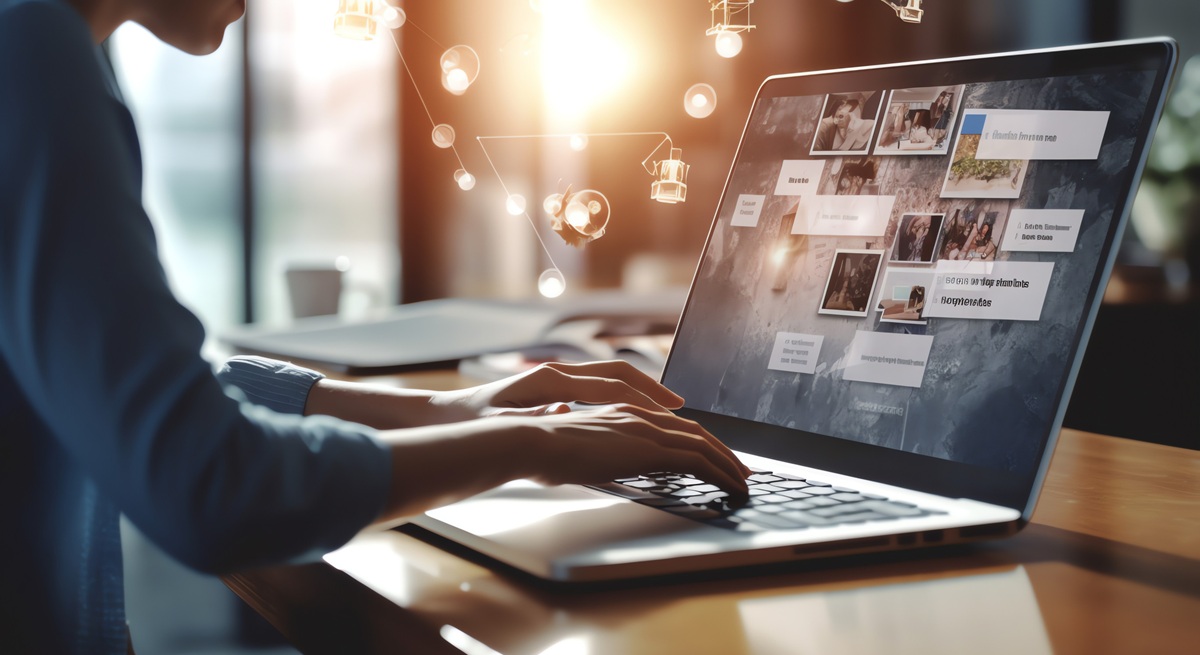
Google’s SGE: What Agencies Should Ask White Label SEO Partners
Search is changing fast. With the rise of Google’s Search Generative Experience (SGE), also known as AI Overviews, agencies and their white label SEO partners must rethink how they approach optimization. SGE adds generative summaries directly into the search results, often appearing above or beside traditional links. Because these summaries deliver quick answers, they can significantly shift how people click, scroll, and interact with search pages.
Studies released after Google expanded AI Overviews show that click-through rates for top organic results have dropped sharply, with the first result losing nearly a third of its previous clicks. Other research shows that zero-click searches have increased as users find everything they need in the AI-generated summary. All of this changes how traffic flows across the search ecosystem.
For agencies, especially smaller ones leaning on white label SEO services, these shifts raise the stakes. Clients expect guidance on SGE, not just traditional SEO. That means partnering with a white label SEO agency capable of meeting today’s search realities. If a partner can’t prove they understand SGE, the risks are simple: fewer clicks for clients, thinner margins for your agency, and shrinking trust over time.
What SGE Complicates for Small Agencies and Their Clients?
SGE doesn’t replace organic search, but it changes how people interact with it. As AI-driven summaries become a regular part of the results page, agencies are dealing with a new set of challenges that affect visibility, reporting, and content strategy.
1. Visibility Versus Clicks
AI Overviews often answer a user’s question before they ever visit a website. A quick explanation, a comparison, or a step-by-step answer can all show up in the summary itself. This makes informational queries harder to monetize because users don’t feel the need to click through. Agencies that rely on top-of-funnel traffic see this most clearly, since these queries are the ones most likely to trigger summaries.
2. Traditional Ranking Signals Are Less Reliable
Old habits like publishing long, heavily optimized posts don’t carry as much weight anymore. SGE favors content that stays focused, reads cleanly, and makes its expertise obvious within seconds. A page might hold a good organic position but still get passed over for the AI summary if the structure, clarity, or authority cues aren’t strong enough.
3. Measurement and Attribution Become Harder
When users get what they need without clicking, analytics tools miss part of the story. A page may influence a decision even if the visitor never lands on it. Agencies now need to look at wider signals such as presence in AI summaries, impressions, branded query growth, assisted conversions, and return-to-search behavior. This shifts reporting away from simple traffic numbers and towards visibility and influence.
4. Content Provenance and Trust Matter More
SGE leans heavily on content that shows its sources and expertise. Pages with bylines, citations, original insights, and clear expertise signals stand out. Content that looks vague, generic, or poorly attributed can be skipped or summarized inaccurately, which hurts both visibility and brand trust.
5. Structured Data Becomes Essential
Semantic signals are now a major factor in what SGE chooses to summarize. Schema markup, clearly defined entities, and connections to known data sources make it easier for the AI to understand and surface a page. Without structured data, content is less likely to be pulled into summaries, regardless of how well it ranks.
6. Faster Iteration is Mandatory
The old content workflow of planning, writing, editing, and publishing over several weeks no longer keeps up with SGE. AI summaries change quickly as Google refines how it interprets intent and quality. Agencies need to experiment with formats, refresh pages more often, and adjust answer blocks, FAQs, and summaries as patterns shift. The agencies that move slowly lose ground because competitors can adapt their content in days instead of months.

If your white label SEO partner can’t work at this pace or explain how they’re staying ahead of SGE, you’re exposed to drops in visibility, fewer leads, and slipping client trust. This isn’t an area where “set it and forget it” works anymore.
What Agencies Should Ask White Label SEO Partners?
The best way to protect your clients is to vet your SEO partner with clear and practical questions. Below is a list your agency can use to check whether a provider is truly prepared for SGE. Each question explains why it matters and what you should expect from a strong partner.
1. SGE Understanding and Roadmap
Start by asking how the partner defines SGE or AI Overviews and what their roadmap looks like for the next few quarters. Anyone who can’t break it down in simple terms won’t be able to build a strategy that holds up. You want a team that follows Google’s updates, tests early, and turns those insights into real processes.
A reliable partner maintains a written SGE playbook, explains how they structure content to improve the chance of being pulled into AI summaries, and shares quarterly testing results. They should be able to show what’s working now, not rely on vague predictions.
Request: A one-page SGE playbook and a few recent experiment summaries.
2. Content Format and Intent Mapping
SGE doesn’t look the same for every query. Some keywords show an overview, while others lean toward instructions or comparisons. A good partner maps these patterns to the content they produce so the structure matches the intent of the search.
A solid answer includes clear intent clusters, short lead summaries, precise answer blocks, and briefs designed to support SGE-friendly formats. If they can show how they plan content around these triggers before writing, that’s a strong sign.
Request: A content brief with a working headline, a 40–80 word summary, and citations.
3. Evidence and Citation Strategy
SGE relies heavily on strong sourcing. You should ask how the partner verifies information and keeps data accurate. Weak or unverified sources lower your visibility in AI Overviews and put your credibility at risk.
The best partners use reputable data, add inline citations, verify claims before publishing, and provide full reference lists. This helps the content earn trust signals that influence both ranking and visibility.
Request: A short article sample with inline citations and a complete source list.
4. Structured Data and Schema Optimization
Structured data gives Google context and improves your chances of being featured in SGE. Your partner should understand the most important schema types and how to apply them across different content types. This includes FAQ, how-to, article, product, and local business schema, along with custom options for niche sites.
Look for partners who use automated schema tools to keep large sites consistent. They should also be able to show where the schema made a measurable difference.
Request: Before-and-after examples showing schema updates and their impact.
5. Prompt and Snippet Testing
AI summaries are sensitive to how information is phrased. Even small changes in the opening paragraph or answer sections can influence visibility. Your partner should run prompt tests, experiment with snippet formats, and track their results.
A strong partner documents variations, compares outcomes, and shares data that shows how adjustments affected impressions or click-through rate. You want proof that they test intentionally, not guess.
Request: Two recent snippet or prompt test logs with clear outcomes.
6. SERP Feature and AI Overview Tracking
SGE visibility is a separate performance layer, and your partner needs to track it directly. If they don’t monitor AI Overviews alongside traditional rankings, you’ll miss insights that shape strategy.
Look for reporting that includes AI Overview impressions, SERP features, organic rankings, and engagement in one place. They should show visibility trends and how SGE affects client demand.
Request: A dashboard or reporting snapshot with SGE-specific tracking.
7. Attribution and KPI Reframing
SGE reduces clicks in many categories, so old performance metrics no longer tell the whole story. Ask how they rework KPIs to capture value beyond traffic alone. You need a partner who understands impression-based reporting, assisted conversions, and multi-touch attribution.
If they still measure success by clicks only, they’re not prepared for today’s search landscape. Updated metrics prove they understand the shift in user behavior.
Request: A KPI proposal that reflects current SGE realities.
8. Content Provenance and Safety
Accuracy matters more than ever with AI systems pulling data from countless sources. Ask how your partner prevents misinformation and what their review flow looks like. The goal is to reduce risk and keep your brand safe.
A strong partner uses human review, verifies claims, checks sources, and fixes errors quickly. They should be able to explain how they ensure content is safe, reliable, and trustworthy across all channels.
Request: Their content quality assurance checklist.
9. Technical SEO Readiness for SGE
SGE still relies on strong technical SEO. If Google can’t crawl or interpret your content, you won’t appear in AI Overviews. Your partner should handle site speed, internal linking, entity optimization, clean structure, and author details that add clarity.
A capable partner can share a technical audit that highlights SGE-specific opportunities like entity gaps, crawl issues, and content hierarchy problems.
Request: A technical audit sample with notes on SGE-related factors.
10. Experimentation Cadence and Fast Failure
SGE evolves fast, so your partner has to move quickly too. Ask about their testing schedule, how they track results, and how they decide when to adjust. Look for teams that run monthly experiments and document their findings in a clear, repeatable format.
A strong partner tests often, learns fast, and adapts without delay. This rhythm helps them stay ahead of the shifts in AI-generated search.
Request: A recent experiment log with takeaways.
Tactical Checklist — Proof to Request from Your Partner
Before choosing a white label SEO agency, ask for:
- SGE Playbook Sample: Shows their strategic approach to AI Overviews, testing schedules, and optimization roadmap.
- SGE-Optimized Content Brief: Demonstrates how they structure articles to match user intent for overviews, step-by-step guides, or comparisons.
- Schema Implementation Matrix: Details which structured data types they deploy for FAQs, how-tos, articles, and local business pages, including automated insertion processes.
- Recent Snippet or Prompt Test Results: Provides proof of experimentation with lead summaries, answer blocks, and phrasing variations to optimize for SGE citations.
- SERP Monitoring Dashboard Screenshot: Confirms they track AI Overview visibility, impressions, and assisted conversions in a measurable, client-reportable way.
- Provenance and Accuracy Guidelines: Outlines their process for sourcing content, verifying data, and reducing misinformation risks.
- Live Sample Content with Citations: Demonstrates that their content is not only well-written but citable, transparent, and backed by reliable sources.
- Technical SEO Audit Including SGE Items: Highlights crawlability, site speed, internal linking, entity markup, and pillar structures optimized for AI-driven summaries.
- Snippet and Prompt Test Logs: Offers documented outcomes of A/B testing, CTR improvements, or impression gains, proving their iterative approach.
- KPI Proposal Built for SGE: Shows how they track value beyond clicks, including impression-based metrics, scroll signals, multi-touch attribution, and downstream conversions.
- Source-Attribution Standards: Confirms that all content has transparent references, inline citations, and a verifiable source list to maintain credibility.
- Updated NDA or SLA Covering SGE-Based Execution: Ensures confidentiality and sets clear expectations around work that includes AI-optimized content and testing protocols.

Quick Wins Agencies Can Apply Immediately
Even before you fully update your workflow, here are simple steps you can implement right now -
- Lead Summary Paragraph: Start pillar pages with an 80-word summary containing two or three citations. This makes your content easier for AI to reference.
- Mini FAQ Blocks: Add short, clear Q&A sections and apply FAQ schema to help AI extract information.
- Provenance Block: Place a “Sources” section at the top or bottom of your content. It boosts trust and clarity for both users and AI.
- SGE Experimental Pages: Publish five short test pages each month, experiment with summary styles, and track impressions and assisted conversions.
How DashClicks Helps Agencies Prepare for Google SGE?
DashClicks supports agencies with a full suite of white label SEO services built for today’s search environment. Their process emphasizes SGE-friendly content structures, clear intent mapping, and comprehensive technical optimization. Agencies using DashClicks can scale content plans without expanding their internal team, while still offering high-quality deliverables optimized for AI summaries.
DashClicks also provides extensive schema support, fast implementation cycles, and flexible reporting dashboards. This helps agencies adapt quickly as SGE evolves. With enterprise-level fulfillment and white-label reporting, agencies retain full control while offering clients modern, SGE-aligned SEO solutions.
Conclusion
Google SGE is reshaping how people search and how agencies must think about SEO. Early adopters who build systems for structured data, intent-driven content, and continuous experimentation will stay ahead as generative search expands. With the right white label SEO partner, agencies can move faster, scale smarter, and protect long-term client performance. Preparing now means stronger results, fewer surprises, and better retention.


No results found.
Please try different keywords.
Get Started with
DashClicks Today
Get found online, convert leads faster, generate more revenue, and improve your reputation with our all-in-one platform.
.svg)
Unlimited Sub-Accounts
.svg)
Unlimited Users
.svg)
All Apps
.svg)
All Features
.svg)
White-Labeled
.svg)
Active Community
.svg)
Mobile App
.svg)
Live Support
.svg)
100+ Tutorials
.svg)
Unlimited Sub-Accounts
.svg)
Unlimited Users
.svg)
All Apps
.svg)
All Features
.svg)
White-Labeled
.svg)
Active Community
.svg)
Mobile App
.svg)
Live Support
.svg)
100+ Tutorials
.svg)
Unlimited Sub-Accounts
.svg)
Unlimited Users
.svg)
All Apps
.svg)
All Features
.svg)
White-Labeled
.svg)
Active Community
.svg)
Mobile App
.svg)
Live Support
.svg)
100+ Tutorials



.svg)
.svg)
.svg)
.svg)
.svg)


